 14/07/2009 14:16 14/07/2009 14:16 |
|
| | | OFFLINE | | Post: 17.936
Post: 605 | Registrato il: 28/08/2005
Registrato il: 20/01/2009 | Administratore | Utente Senior | |
|

 The distressing news from Iraq was coming in even as the Pope was en route to Les Combes yesterday, and his reaction was prompt.
Benedict XVI deplores
The distressing news from Iraq was coming in even as the Pope was en route to Les Combes yesterday, and his reaction was prompt.
Benedict XVI deplores
new church bombings in Iraq

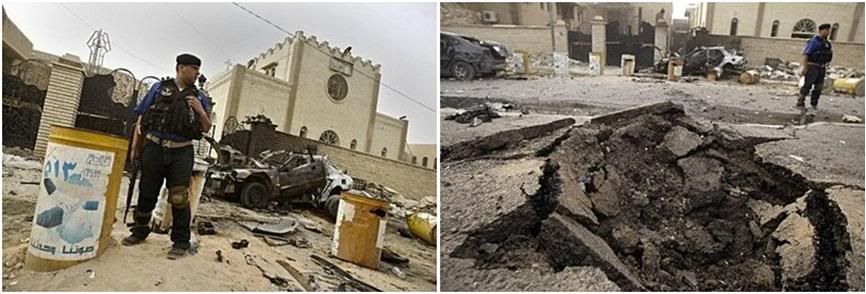
BAGHDAD, Iraq, JULY 13, 2009 (Zenit.org).- Benedict XVI has decried a new wave of attacks against churches in Iraq, urging authorities to spare no efforts in promoting peaceful coexistence.
An explosion this morning near Our Lady of Fatima Church in eastern Baghdad marked the seventh bombing of Chaldean and Orthodox Churches since Saturday. The attacks have left at least four dead and 35 injured.
The previous bombings took place at two churches in the western part of the city Saturday night, three churches Sunday afternoon, and one Sunday evening.
In a telegram signed by Secretary of State Cardinal Tarcisio Bertone, the Pope assured that he is praying "for a conversion of heart for the perpetrators of violence," and he urged authorities "to do everything possible to promote a just and peaceful coexistence for all of the sectors of the Iraqi population."
The papal message was sent to Cardinal Emmanuel III Delly, archbishop of Baghdad. The Holy Father, who arrived today in the northern Alps for his summer vacation, assured "his prayer and spiritual closeness to the Catholic and Orthodox communities of the Iraqi capital."
Aid to the Church in Need reported that St. Mary's Chaldean Church was damaged by a car bomb Sunday evening that exploded as parishioners were leaving Mass.
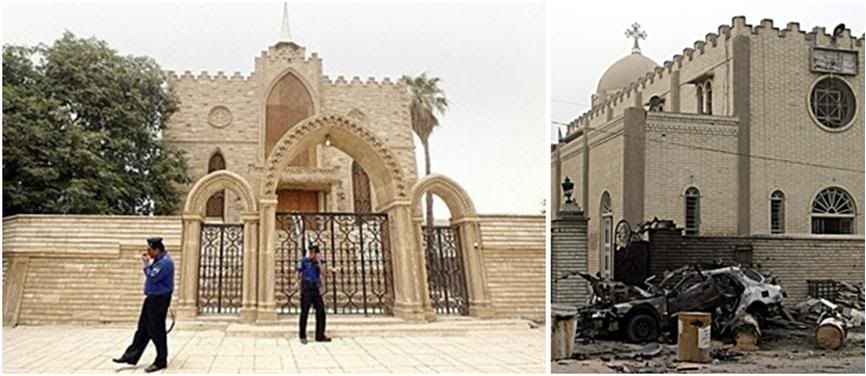 Left photo shows St. Mary's Church under guard after the Sunday bombing.
Left photo shows St. Mary's Church under guard after the Sunday bombing.
Other attacks targeted St. George's Church and St. Joseph's Church. Most of the church buildings sustained damage.
The aid agency reported that the continued violence against Christians has already forced 200,000 to flee to neighboring countries, while some 50,000 have taken refuge in northern Iraq.
Thus, the Christian community in the region has dropped from an estimated 1 million in 2003 to less than 400,000 currently.
Iraqi religious leaders expressed concern that this is the start of a new phase of violence, after having enjoyed a recent climate of relative calm.
"We are upset about what is happening in Iraq," Cardinal Delly lamented on Iraqi television, "because today, places that in the past and during the war served as places of refuge for Christians and Muslims, are now object of attacks."
The cardinal decried aggression against Christian churches and mosques, and urged a "spirit of tolerance".
[Modificato da TERESA BENEDETTA 04/12/2011 23:32] |
| |
|
| |
 14/07/2009 14:51 14/07/2009 14:51 |
|
| | | OFFLINE | | Post: 17.937
Post: 606 | Registrato il: 28/08/2005
Registrato il: 20/01/2009 | Administratore | Utente Senior | |
|

July 14
 Blessed Kateri Tekakwitha (USA, 1656-1680)
Blessed Kateri Tekakwitha (USA, 1656-1680)
Algonquin Indian, 'Lily of the Mohawks'
Virgin
OR today.

At the Sunday Angelus, before leaving for Val D'Aosta,
the Holy Father speaks out
'Against the absolutism of technology'
Also makes an appeal for reconciliation in Honduras
Other Page 1 stories: The Pope reaches out to Iraqi Christians in a series of new bombings of Catholic churches; Israeli Prime Minister Netanyahu wants to resume peace talks with the Palestinians but Abu Mazen wants proof of Israeli 'respect for the Road Map' first; and Somalian troops engage Muslim insurgents in the continuing battle of Mogadishu. And an inside-page review of the latest Harry Potter movie praises its positive teaching values behind all the surface 'magic'.
THE POPE IS ON VACATION - Day 2 today.
[Modificato da TERESA BENEDETTA 15/07/2009 14:26] |
| |
 15/07/2009 01:15 15/07/2009 01:15 |
|
| | | OFFLINE | | Post: 17.941
Post: 610 | Registrato il: 28/08/2005
Registrato il: 20/01/2009 | Administratore | Utente Senior | |
|
 THE POPE'S VACATION: DAY 2
THE POPE'S VACATION: DAY 2
Sad news from Afghanistan and Iraq,
prayers, and his first walkabout
by Elisa Pinna

LES COMBES, Introd, Val D'Aosta, July 14 (Translated from ANSA) - News of the attack on Italian soldiers in Afghanistan killing a young man from Campobasso reached the chalet in Les Combes late in the morning today where Pope Benedict XVI arrived yesterday to begin his annual summer vacation.
The Pope was informed about it when he came back from his first walk in the nearby woods with his private secretary, Mons. Georg Gaenswein. He expressed his deep sorrow and issued a message assuring his prayers for the young man, for his wounded colleagues and for their families.
 The above photo showing the rear of the Pope's vacation residence appears in tomorrow's (7/15/09) issue of L'Osservatore Romano; earlier photos (below) show the Pope's second-floor rooms opening to a view of Mont Blanc, the highest peak of the Alps. Les Combes is situated at 1300 meters (4,200 ft) altitude.
The above photo showing the rear of the Pope's vacation residence appears in tomorrow's (7/15/09) issue of L'Osservatore Romano; earlier photos (below) show the Pope's second-floor rooms opening to a view of Mont Blanc, the highest peak of the Alps. Les Combes is situated at 1300 meters (4,200 ft) altitude.
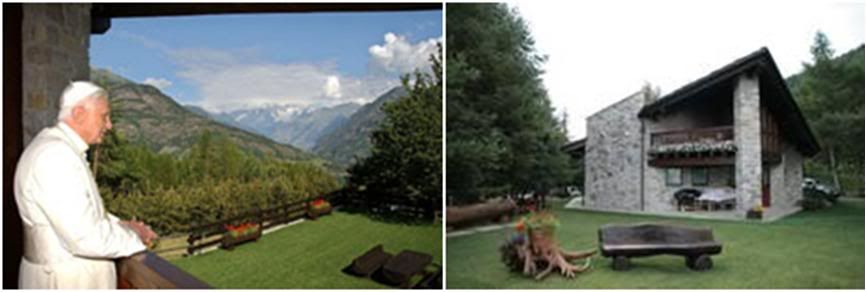
Arriving from Rome at midday yesterday, the Pope was apparently tired enough that he failed to take his usual afternoon walk. He indicated yesterday that he intended to rest a bit.
There is no talk so far about excursions outside the perimeter of the vacation residence, although a helicopter is on station in the adjoining meadow for any contingency.
Compared to ordinary mortals, however, the Pope's vacation continues to follow the rhythm of the priest's liturgical day, including the daily morning Mass and the Divine Office (Liturgy of the Hours) that is prayed seven times a day.
Papa Ratzinger is an early riser, and that was no different today. Before breakfast, he said Mass in the chapel within the chalet. Afterwards, he read the newspapers and proceeded to write, study and meditate.
Shortly after Tierce (mid-morning prayer), he decided to avail of the bea utiful day - which was sunny, with clouds alternating with clear skies - and took a walk in the nearby fir and beech forest with Mons, Gaenswein.
They came back in time for the noonday Office and Angelus. Afterwards, they inaugurated the chalet's new lawn umbrella by taking lunch outdoors - the usual frugal meal prepared by two of the Memores housekeepers who came to Les Combes with the Pope.
The Salesians (who own the chalet and have an adjoining vacation colony) provide the food supplies - and although the menu was not known, the Pope, it is said, did have his strudel, courtesy of a bakery in Villeneuve, the nearest big town.
And his orange juice, even if his companions availed of the Valdostan wines, provided generously by Introd Mayor Osvaldo Naudin.
After his usual post-luncheon rest, the Pope returned to his study, then probably took another walk in the woods with Gaenswein.
Then, Vespers at 7 p.m. and dinner.
Three hundred security men - between the Vatican's own and those of the Italian government - have been assigned to guarantee the Pope's safety and his privacy.
Post-script on the RAI-TV
newsman who 'dissed' the Pope
Antonio Di Bella, the RAI editor who yesterday sought to minimize the offensive remark about the Pope made by Rai-3's Vatican correspondent Roberto Balducci after a report on the Sunday Angelus.
Di Bella today announced he is replacing Balducci as the channel's Vatican correspondent.
Earlier, Balducci wrote Di Bella syaing he was unhappy that his remarks "may have caused damage to you, to our newscast and to the organization", while reiterating his respect for the Vatican [but not for the Pope - and apparently no apology to the Pope either. But neither has Di Bella expressed any apology to the Pope].
He sought to explain his remarks, saying it stemmed from his original observation that "The two cats who are reportedly awaiting the Pope up in the mountains will surely draw a smile from him - ", going on to say "at least as much as the proverbial four cats, maybe a few more, who still have the courage and the patience to listen to him", claiming that he had in mind the image of a crowded St. Peter's Square when he said this. [Yeah, right! Whether in Italian or in English, that last clause cannot be other than ridicule, if not contempt.]
Lella on her blog thinks Di Bella over-reacted. I disagree. It was the least he could do, seeing as no one has yet apologized to the Pope for anything. He didn't fire Balducci, he simply is taking him off the Vatican assignment.
This makes sense, as Balducci obviously has a lot of learn in terms of discretion and propriety, particularly when you have to report daily on the Vicar of Christ. You have no business covering the Pope if you forget this.
[Modificato da TERESA BENEDETTA 15/07/2009 14:59] |
| |
 15/07/2009 03:29 15/07/2009 03:29 |
|
| | | OFFLINE | | Post: 17.942
Post: 611 | Registrato il: 28/08/2005
Registrato il: 20/01/2009 | Administratore | Utente Senior | |
|
 As if in answer to Balducci's sarcasm:
Who tops Italy's best-seller list this week -
As if in answer to Balducci's sarcasm:
Who tops Italy's best-seller list this week -
surpassing a weeks-long fictional bestseller?
Adapted from

So only "four cats have the courage and patience to listen to the words" of Benedict XVI!
Then who has been buying Caritas in veritate which, in less than a week climbed to the top of Italy's best-seller list, ahead of a novel that had been the chart-topper for weeks?
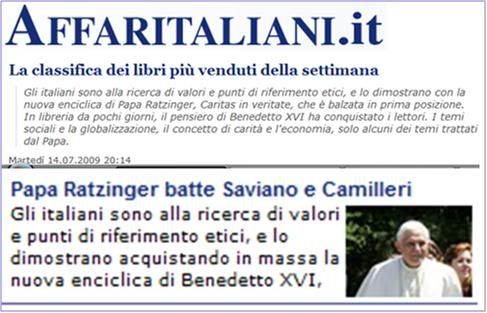 'THE POPE BEATS SAVILLANO AND CAMILLERI!
'THE POPE BEATS SAVILLANO AND CAMILLERI!
"Italians are in search of values and reference points - and they show this
by their mass acquisition of Benedict XVI's new encyclical". LEV, the Vatican publishing house, printed an initial 530,000 copies in Italian, augmented by at least another half a million distributed as supplements to Avvenire and Famiglia Cristiana. Not to mention the texts published by Italy's 150 diocesan newspapers .[And with so many giveaways, people are still buying the commercial edition!]
The supplement that came with the Wednesday (July 8) issue of L'Osservatore Romano has already become a collector's item.
[Frankly, I am happily surprised by the popular interest in Caritas in veritate - a very 'technical' text compared to the 'pure' theology and philosophy of the first two encyclicals. But then, the popular success of thw first two encyclicals was a great big surprise to everyone as well. Not to mention Sacramentum caritatis, the post-Synodal exhortation on the Eucharist.
Since when have papal documents - teaching papers! - ever been best-sellers competing up there with 'regular books'? Only with Benedict XVI!]
 Benedict XVI: Recommended reading
Benedict XVI: Recommended reading
for moderns let down by modernity
by Bruno Mastroianni
Translated from

July 14, 2009
The idea that the world can use love, not as a vague sentiment, but as something solid and concrete rooted in the truth about man and on reality - caritas in veritate - has hit the mark.
On the left as on the right, among labor unions and entrepreneurs, economists and newsmen: everybody has heard the authoritative voice of the Pope.
The fact is that the era of enthusiasm over living 'as if God does not exist' is coming to an end. The global crisis has brought that clearly to light.
All this modernity has failed, over the past two centuries, to deliver what it promised. So there is widespread disssatisfaction and a desire for fresh air.
And that is why the encylical has been so well received.
And journalistic spin has not been possible because everyone has read it - or can easily do so, if they wish. [Well, no! There are still quite a number of people who are too lazy to read the whole thing and prefer to get their knowledge of it - as well as what they ought to think about it - from what the media tell them! And there certainly has been no lack of self-serving (or ideology-serving) media spin on CIV!]
They are rediscovering what can be reasonable, shareable and stimulating from Benedict XVI, who is reconnecting human events to the ultimate sense of existence.
In this climate, the meeting between the Pope and the American President must be instructive.
While the media were anticipating a confrontation on bioethical issues, the two used the occasion to size up each other. [And of course, it was a confrontation on bio-ethical issues - not all of it, surely - but the part of it that the Vatican unmistakably wished to be placed up front for all to see.]
Obama promised to reduce abortions [an empty promise, by the way, since he personally and his party promote abortion as a human right, so how does that help reduce abortions? And yet, media has reported this promise uncritically and positively, without even questioning its obvious improbability!], and the Pope handed him a copy of Dignitas personae - the document that explains very well why the defense of the dignity of man (and of human life) is not a fixation on the part of Catholics but one that concerns everybody.
If only Obama reads it with attention [or reads it at all!], he would discover how reasonable, shrable and stimulating the Church is when it reminds man that the future depends on the capacity to defend life from its very beginning.
How it is all question of love in truth.
[Modificato da TERESA BENEDETTA 15/07/2009 06:33] |
| |
 15/07/2009 05:42 15/07/2009 05:42 |
|
| | | OFFLINE | | Post: 17.943
Post: 612 | Registrato il: 28/08/2005
Registrato il: 20/01/2009 | Administratore | Utente Senior | |
|
 Of course, it would be Father Schall who would do what I have been waiting for someone to do - to consider CIV above the usual 'social encyclical' for its carefully designed theological beginning and conclusion, which set up and sum up, respectively, the doctrinal premises for what is necessarily a technical analysis of the world's problems - which are concretely material but cannot be overcome without factoring God into everything we do.
Of course, it would be Father Schall who would do what I have been waiting for someone to do - to consider CIV above the usual 'social encyclical' for its carefully designed theological beginning and conclusion, which set up and sum up, respectively, the doctrinal premises for what is necessarily a technical analysis of the world's problems - which are concretely material but cannot be overcome without factoring God into everything we do.

JulY 14, 2009
 ignatiusinsight.com/features2009/schall_caritasinveritate_ju...
ignatiusinsight.com/features2009/schall_caritasinveritate_ju...
"Charity in truth, to which Jesus Christ bore witness by his earthly life and especially by his death and resurrection, is the principal driving force behind the authentic development of every person and of all humanity."
- Benedict XVI, Caritas in Veritate, (#1).
"The Trinity is absolute unity insofar as the three divine Persons are pure relationality. The reciprocal transparency among the divine Persons is total and the bond between each of them complete, since they constitute a unique and absolute unity. God desires to incorporate us into this reality of communion as well: 'that they may be one even as we are one' (Jn. 17:22).
"The Church is a sign and instrument of this unity. Relationships between human beings throughout history cannot but be enriched by reference to this divine model. In particular, in the light of the revealed mystery of the Trinity, we understand that true openness does not mean loss of individual identity but profound interpenetration."
- Caritas in Veritate, (#54).
I.
The publication of a social encyclical is a significant event both in the Church and in the world. Many people will have heard even the Latin titles, which are the names given to the most famous of them, Rerum Novarum, Quadragesimo Anno, Mater et Magistra, Pacem in Terris, Populorum Progressio, and Centesimus Annus, not to mention Gaudium et Spes, a decree of the Second Vatican Council.
We read in Scripture that a difference is found between the world and the Church. This difference often becomes clear in the way the world understands and receives a social encyclical. The world often considers its relative autonomy to be absolute so that no guidance or advice from outside its own control will be admitted.
In not a few countries in the world, even today, opposition to the Church's presence and freedom is juridical and intense. But even in countries where freedom of the press is guaranteed, an encyclical is often interpreted in an unrecognizable or ideological way.
For its part, a social encyclical tries to say something significant and meaningful to the world about the world in terms of truth and human worth.
Within it, we often find words like politics, economics, market, violence, profit, capitalism, socialism, justice, technology, development, corruption, rights, freedom, constitution, duties, and any number of other words we see or hear every day in the media.
In general, unless it absolutely has to, the Church does not like to be "polemical." But it does have to be truthful. It seeks to make common ground on some one or more basic points on which agreement of principle or practice is feasible and coherent.
When it does not agree with technical, theoretical, or popular social and political concepts, at least the encyclical seeks to state accurately what is at issue.
It addresses the controverted issue intelligently and accurately. It is better simply to "disagree" or "agree to disagree" than to arrive at common grounds that are really denials of the basic differences.
The Church can live with differences. It cannot live with untruths on any side, especially its own. Even in the case of contingent, practical matters — which politics and economics mostly are — what is looked for is the most proper, most probable way of incorporating truth into an action or polity.
Right away, when dealing with such social or political notions, the Church, to clear the air, disassociates itself from any thought that it might have or provide all the solutions to temporal problems. "The Church does not have technical solutions to offer and does not claim 'to interfere in anyway in the politics of States'" (#10).
So why should it say anything? Benedict explains: "She (the Church) does, however, have a mission to truth to accomplish, in every time and circumstance, for a society that is attuned to man, to his dignity, to his vocation."
Simply put, at times things should be said. Action first depends on truth. To not state what is true is irresponsible. The truth about man should be spoken, even at high cost. This responsibility to do so is why the Church has and honors martyrs.
Christianity and philosophy, in the persons of Christ and Socrates, are both founded on this principle. Finally, only truth will protect what man ought to be and ought to become. He is not simply a malleable being who can become whatever he wants. He is a being who seeks to be the truth he ought to be.
II.
Thus, a "mission of truth" exists that transcends the limits of every polity regardless of time, place, or configuration. The polity itself is a limited relationship. What follows?
"Without truth it is easy to fall into an empiricist and skeptical view of life, incapable of rising to the level of praxis because of a lack of interest in grasping the values — sometimes even the meanings —with which to judge and direct it."
Benedict adds a pithy phrase of great profundity: "Fidelity to man requires fidelity to the truth, which alone is the guarantee of freedom and of the possibility of integral human development."
The phrase "integral human development" is one of the organizing principles of this encyclical.
John Paul II, as I recall, called the freedom of religion the "first freedom," a phrase he may have gotten from our First Amendment. Benedict makes an interesting remark about this issue of religious freedom.
He says quite frankly that not all religions are the same, that some even tend to violence and deform fundamental aspects of human life. We can dispute these latter on this score but only if we are allowed to do so.
The fact is, however, that "the Christian religion and other religions can offer their contribution to development only if God has a place in the public realm, specifically in regard to its cultural, social, economic, and particularly its political dimensions" (#56).
In a world used to thinking sloppily on "the separation of Church and State," a phrase not found in America's founding documents (while "freedom of religion" is), these words are very significant.
"The Church's social doctrine came into being in order to claim 'citizenship status' for the Christian religion. Denying the right to profess one's religion in public and the right to being the truths of faith to bear upon public life has negative consequences for true development" (#56).
The Pope is thinking of the Europe of the nineteenth century. The Church through concordats, or laws, or political parties, or unions, had to carve out a space in which it could speak in the public forum by virtue of its own understanding of a truth valid for all men.
It needed to be legally free to build churches, schools, or other institutions, for citizens to participate in public life as legitimate citizens, for the pastor to teach and preach what the Church believes.
In almost every meeting with heads of state or ambassadors from states where the Church does not have even today this "citizenship status" — and there are not a few — the Pope, be it John Paul II or Benedict, brings this issue up.
Without the evangelization efforts of the Church the simple effort of people to live free lives in truth becomes jeopardized.
The Pope does not deny a private sphere of religious faith and practice, but here he insists that stating the truth is a public good to which it is entitled both for the well-being of the polity and for the guarantee of truth.
When the state denies any public presence, it means that it claims for itself an absolute, even divine power.
"Reason always stands in need of being purified by faith: this also holds for political reason, which must not consider itself omnipotent."
John Paul II spoke of the "purification of memory," Benedict speaks of the "purification of political reason.
Many readings of this document will concern themselves with the various economic and political suggestions found in it. For the most part they are informed, not infallible, judgments about the contingent laws and actions of politics, economics, finance, ecology, or globalization.
Not a few of the suggestions in the encyclical can be wondered about. Usually, the pope shows some awareness of the tenuousness or prudence of these suggestions. Some people find in them a heady optimism; others find even a naivete.
But these judgments are intended to address, at some more than purely abstract level, a given issue. Without this more informed effort, the Church often finds itself being accused of talking only in abstractions and glittering pieties.
Probably the most controversial suggestion of the encyclical has to do with the advisability of a real international authority capable of carrying out necessary reforms on a worldwide scale with power of enforcement.
The Pope is a German, so he has to be aware of the multiple lineages and dangers of such suggestions. People remember that the Holy Roman Empire and the "Third Reich" were proposals for a world order with authority.
Neither the League of Nations nor the United Nations Organization, as the Pope intimates in this document, gives much comfort as examples of successful world authority. It is noteworthy the document suggests some sort of third approach. But at this stage, it is little more than a point for discussion.
In one sense, even though he wrote of city-states, an implication for a general authority exists in the very logic of Aristotle's politics extended to include a real common good for all, a proposal many find in Aquinas also.
Still, following the Book of Revelation, as Oscar Cullmann once pointed out, there is danger of a "beast," of a new Babylon, that thinks only of itself and sets itself up against God.
The Pope's writings are full of warnings against this latter absolutist danger. He touches on it in this encyclical but his attention is mainly on the danger of a breakdown of the world economic order.
The world seems to lack an authoritative locus of action for greater goods. This authority, in the Pope's mind, would be an accepted and carefully limited authority. The Pope is usually considered an Augustinian thinker, but in this proposal, he does not show Augustine's usual caution about the abuse of power.
III.
Clearly, this encyclical is as much, if not more, about truth as it is about charity. Indeed, the necessity of dealing with specifically charity arose because it was the fuzziness that grew up about a use of the virtue of charity that was causing moral and political problems everywhere.
In Deus Caritas Est, Benedict had already spelled out the scriptural and philosophical meaning of this word. He talked of "eros, philia, and agape', the three Greek words found in Scripture and in the philosophers to depict different aspects of love.
The New Testament almost exclusively uses "agape, which means the love that is outgoing, the love in which we first exist. This love that gives being is God's love of us, a creative love. It is this sort of love by which we love one another, our enemies, our God — who also forgives our sins if we choose to have them forgiven.
The first paragraph of this encyclical is tightly ordered to summarize the whole document. Love is a "driving force." It deals with "authentic," not inauthentic, development. It brings out what is already implanted in our being at our very conception and coming to be as human persons.
We are what we are through no power or intention of our own. Love is an "extraordinary force" that gives us "courage" and makes us generous to work for "peace and justice." These latter, peace and justice, do not exist before the former, the truth of our being already what we are not of our own making.
"Each person finds his good by adhering to God's plan for him, in order to realize it fully: in this plan, he finds his truth, and through adherence to this truth he becomes free." Truth is to be defended. There is no freedom without it. God has a plan for each of us. This is why we are.
Here, are we just talking of a few Christians who know something of theological terms? Hardly.
"All people feel the interior impulse to love authentically: love and truth never abandon them completely, because these are the vocation planted by God in the heart and mind of every human person."
This passage, which is very mindful of Augustine, is about what is already "planted" in our hearts. Lest we think this approach is still abstract, we find that it is made concrete in Jesus.
"In Christ, charity and truth becomes the Face of his Person." Jesus is the truth. All human beings belong to His plan.
John Paul II, following certain modern philosophers, also spoke of the astonishment for us for God to have a human Face, precisely because love seeks sight. Ubi eros, ibi oculus.
I have taken some time with this first paragraph because the Pope in this document recasts the center of traditional social teaching. It does not cease to be concerned with justice, but "Charity is the heart of the Church's social doctrine" (#2).
And if charity is the heart of the Church's social doctrine, certain new emphases need to be recognized in our private and public lives. We have to begin with the origin of what we are. We are not of our own origin. Our ultimate origin is the Trinity, nothing less.
We exist because of an abundance of being and love in God. This abundance and its overflow reflect in us, in the way we are with others. This abundance is why we find so much in this encyclical about "gift" and "gratuitousness.
What is unique about this social encyclical, then, is its philosophical and theological depth. It does not allow us to be superficial. It does not seek to explain "social matters" as if they had no ultimate source or as if, even with their own proper order, they stood by themselves.
"Truth, and the love which it reveals, cannot be produced: they can only be received as a gift. The ultimate source is not, and cannot be mankind, but only God, who is himself Truth and Love. ... That which is prior to us and constitutes us—subsistent Love and Truth—shows us what goodness is, and in what our true happiness consist. It shows us the road to true development" (#52).
Thus, not only do "duties" stand before "rights," as Benedict teaches, but "gift" stands before and beyond them both without denying their validity.
Man is a spiritual being. He freely and knowingly relates himself to others, including God.
"A metaphysical understanding of the relations between persons is therefore of great benefit for their development," Benedict writes. "In this regard, reason finds inspiration and direction in Christian revelation, according to which the human community does not absorb the individual, annihilating his autonomy, as happens in the various forms of totalitarianism, but rather values him all the more because the relation between individual and community is a relation between one totality and another" (#53).
That passage alone shows how much the loss of metaphysics in our schools affects our understanding of the flourishing of the human person. But the "community" is not itself another substantial being as the individuals who make it up are.
Benedict is right to stress this understanding of the human person which remains itself in its relations even with God. This is why we have the resurrection of the body.
So when, as we saw in the citation at the beginning of this reflection, we ask, "What is our grounding in being?", we have to go back to the Trinity, "the relationship between the Persons of the Trinity within the one divine Substance. The Trinity is absolute unity insofar as the three divine Persons are pure relationality" (#54).
All three Persons are "transparent" to one another. "God desires to incorporate us into this reality of community. "In particular, in the light of the revealed mystery of the Trinity, we understand that true openness does not mean loss of individual identity but profound interpenetration.
Again, in a "social encyclical", a Pope understands that what it is we are created for is not this world itself, though we have something responsible to do in it.
The essence of God's love of us is an agape that we do not give ourselves. Hence, we have the constant theme that by itself, politics will not really be able to solve its own problems because the real problems of every man in every polity begin and end with his proper relation to God.
Still, and in conclusion, "Because it is a gift received by everyone, charity in truth is a force that builds community, it brings all people together without imposing barriers or limits."
If it is a gift received by everyone, his principal task is to recognize and bring forth what is already there in his being. This bringing forth is not a "self-making" but it is a doing on the basis of what the divine plan has already seen in the being of each existing person. That this plan achieves its end in the inner life of the Trinity, we have to know the truth of what we are.
"The human community that we build by ourselves can never, purely by its own strength, be a fully fraternal community, nor can it overcome every division and become a truly universal community. The unity of the human race, a fraternal communion transcending every barrier, is called into being by the word of God-who-is-love" (#34).
Thus, Caritas in Veritate is a social encyclical that is not just an address about "social problems" but a refocusing of the whole plan of our salvation that takes place in the arena of our actual lives in cities of every description.
We work with what we have. We are made for eternal life, the life of the Trinity, as a gift.
As Benedict said elsewhere, politics is not an "eschatology" that is itself our salvation, rather it is an ethics in which, knowing what we are and what is our destiny, we decide, ultimately, what we are and what we will be.
The gift, the truth, the love is given to us. God can do no more. We are free. Otherwise there is no gift and no love, but there is truth even if we reject God.
[Modificato da TERESA BENEDETTA 15/07/2009 05:44] |
| |
 15/07/2009 14:21 15/07/2009 14:21 |
|
| | | OFFLINE | | Post: 17.946
Post: 615 | Registrato il: 28/08/2005
Registrato il: 20/01/2009 | Administratore | Utente Senior | |
|

July 15
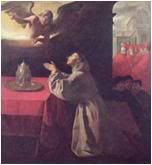 St. Bonaventura
St. Bonaventura
born Giovanni da Fidanza, 1221, Bagnoregio, Italy, d. 1274)
Franciscan, Classmate of St. Thomas Aquinas in Paris
Bishop, Confessor, Doctor of the Church
'Doctor Seraphicus'
OR today.

The only papal story in today's issue is an inside-page interview with the Bishop of Aosta
on the Pope's current vacation. The icon illustrates a story comparing the theologies of
the contemporaries Saints Bonaventure (on his feast day today) and St. Tomas.
Page 1 stories: IRA dissidents disrupt traditional annual marches by Northern Irishmen
(orangists) who favor Northern Ireland continuing as part of the United Kingdom;
Japan prepares for parliamentary elections on August 30; and the UN chief offers help
to mediate Honduras crisis. Inside-page stories include one about Cardinal Newman
from a recent bigraphy, and a reassessment of Oscar Wilde (who met with Pius IX and
died a practising Catholic) in the light of his quest for Beauth and Truth.
THE POPE ON VACATION - DAY 3
[Modificato da TERESA BENEDETTA 15/07/2009 14:24] |
| |
 15/07/2009 15:51 15/07/2009 15:51 |
|
| | | OFFLINE | | Post: 17.947
Post: 616 | Registrato il: 28/08/2005
Registrato il: 20/01/2009 | Administratore | Utente Senior | |
|
 The Pope's Wednesday catecheses
Translated from
The Pope's Wednesday catecheses
Translated from
the Italian service of

July 15, 2009
It's the third day of Benedict XVI's vacation in the mountains of Val D'Aosta. He is resting away from the crowds which, particularly on Wednesday, like today, flock to St. Peter's Square to listen to his catechesis at the General Audience.
Alessandro De Carolis gives an overview of these catecheses, particularly how Benedict XVI has structured them.
It was Pius XII who 'invented' an audience that would be regularly open to the general public, in St. Peter's Square or elsewhere, and during which he could develop the themes of his magisterium.
The first such catechesis preserved in the Holy See's archive was given on April 28, 1939, one and a half months after he had been elected Pope. Almost all the catecheses that year were on matrimony, conjugal love and the family.
Quite different from what we have become accustomed to in Papa Ratzinger's catecheses, of which he has given 22 so far in 2009, during which he ended his Pauline Year cycle on February 4.
The recent volume published by the Vatican publishing house LEV on the Apostle Paul was the sixth [???] one based on Benedict XVI's Wednesday catecheses.
His first cycle, from May 2005 to February 2006, was actually in completion of a cycle begun by John Paul II on the Psalms and Canticles for Lauds and Vespers.
He then began his 'own' catechetical cycles with an individual look at each of the Apostles (including St. Matthias, whom the Eleven picked to replace Judas Iscariot, and St. Paul, to whom he devoted four catecheses in this cycle), ending this in February 2007.
[He explained when he began the series that he wished to present the eternal teachings of the Church established by Jesus Christ through the lives and teachings of those who have been the most prominent witnesses for Christ.]
The third cycle, lasting till June 2008, was on the figures of the early Church - the first and second generations following the Apostles.
He 'interrupted' his chronological presentation of the figures who have shaped the Church through the centuries with his 20-part cycle on St. Paul for the Pauline Year.
Papa Ratzinger then resumed his review of the great Church figures with a cycle on the great writers of the Eastern and Western Churches in the Middle Ages.
The General Audiences have also been an occasion for the Popes to comment on important events for the Pontificate, such as their apostolic trips abroad, encyclicals and special messages to the world, as Benedict XVI recently did to report on his pilgrimage to the Holy Land, on the Year for Priests that he decreed for 2009-2010, and on his third encyclical, Caritas in veritate, which was his last catechesis before going on his annual summer vacation.
The Wednesday General Audiences will resume in Castel Gandolfo in August.
[Modificato da TERESA BENEDETTA 15/07/2009 15:52] |
| |
 15/07/2009 16:20 15/07/2009 16:20 |
|
| | | OFFLINE | | Post: 17.948
Post: 617 | Registrato il: 28/08/2005
Registrato il: 20/01/2009 | Administratore | Utente Senior | |
|
 A revival of Romano Amerio's thought -
A revival of Romano Amerio's thought -
and how it relates closely to
the themes of Benedict XVI's Magisterium
Two outstanding works of Catholic culture are returning to Italian bookstores.
And the taboo on one of the greatest Christian intellectuals of the twentieth century
is crumbling definitively. The question he highlights is also at the center of
Benedict XVI's pontificate: how much can the Church change, and in what way?

ROME, July 15, 2009 – Tomorrow, two volumes that have taken their place among the classics of modern Catholic culture will return to Italian bookstores, published by Lindau. Their content is in striking harmony with the title and foundation of Benedict XVI's third encyclical: Caritas in Veritate.
The author of the two volumes is Romano Amerio, the Swiss scholar, philosopher, and theologian who passed away in 1997 at the age of 92. One of his great admirers, the theologian and mystic Don Divo Barsotti, summed up their contents as follows:
"Amerio essentially says that the gravest evils present today in Western thought, including Catholic thought, are mainly due to a general mental disorder according to which 'caritas' is put before 'veritas', without considering that this disorder also overturns the proper conception that we should have of the Most Holy Trinity."
In effect, Amerio saw precisely in this overturning of the primacy of Logos over love – or in a charity separated from truth – the root of many of the "variations of the Catholic Church in the 20th century": the variations that he described and subjected to criticism in the first and more commanding of the two volumes cited: Iota unum, written between 1935 and 1985; the variations that led him to question whether with them, the Church had not become something other than itself.
Many of the variations analyzed in Iota unum (one iota, i.e., the smallest part) – although just one of them would suffice, one "iota," according to Matthew 5:18*, from which the book's title is taken – would lead the reader to think that there has been an essential mutation in the Church.
*[In the Sermon on the Mount, after the Beatitudes, Jesus says: "Amen, I say to you, until heaven and earth pass away, not the smallest letter or the smallest part of a letter will pass from the law, until all things have taken place" (mt 5,18).]
But Amerio analyzes, he does not judge. Or better, as the fully formed Christian that he is, he leaves the judgment of God. And he recalls that " portae inferi non praevalebunt" (the gates of hell shall not prevail), meaning that for the faith, it is impossible to think that the Church could lose its way. There will always be continuity with Tradition, even if it is amid turbulence that obscures it and leads one to think the contrary.
There is a close connection between the questions posed in Iota unum and Benedict XVI's address to the Roman Curia on December 22, 2005, a fundamental address in terms of the interpretation of Vatican Council II and its relationship with Tradition.
This does not change the fact that the state of the Church as described by Amerio is anything but peaceful.
In the address on December 22, 2005, Benedict XVI compared the babel of the contemporary Church with the upheaval in the fourth century after the Council of Nicaea, described at the time by Saint Basil as "a naval battle in the darkness of a storm."
In the afterword that Enrico Maria Radaelli, a loyal disciple of Amerio, publishes at the end of this new edition of Iota unum, the current situation is instead compared to the Western Schism, meaning the forty years between the 14th and 15th centuries before the Council of Constance, with Christianity leaderless and without a sure "rule of the faith," divided between two or even three popes at one time.
In any case, republished now, Iota unum reasserts itself as a book that is not only extraordinarily relevant, but "constructively Catholic," in harmony with the Church's magisterium. In the afterword, Radaelli demonstrates this in an irrefutable way. [Magister later presents the conclusion of Radaelli's afterword.]
As for the second book, Stat veritas (In place of truth), published by Amerio in 1985, it is in linear continuity with the previous one.
It compares the doctrine of Catholic Tradition with the "variations" that the author identifies in two texts of the magisterium of John Paul II: the apostolic letter Tertio Millennio Adveniente, November 10, 1994, and the address at the Collegium Leoninum in Paderborn on June 24, 1996.
The return to the bookstores of Iota unum and Stat veritas brings justice both to their author and to the de facto censorship that for long years bore down on both of these consummate books of his.
In Italy, the first edition of Iota unum was reprinted three times for a total of 7,000 copies, despite the fact that it ran to almost 700 pages of demanding reading. It was then translated into French, English, Spanish, Portuguese, German, and Dutch. It reached tens of thousands of readers all over the world.
But for official Catholic bodies and Church authorities it was taboo, as of course it was for its adversaries. More of a singular case than a rare one, the book was an underground "long seller." Requests for it continued when the bookstores ran out of copies.
The breaking of the taboo is recent. Conferences, commentaries, reviews. La Civiltà Cattolica and L'Osservatore Romano have taken part in breaking the taboo.
At the beginning of 2009, a first reprinting of Iota unum appeared in Italy, published by the publishing house Fede & Cultura. But this new edition of the book produced by Lindau, together with that of Stat veritas, has the added value of editing and annotation by Amerio's greatest student and intellectual heir, Radaelli.
His two extensive afterwords are genuine essays, indispensable for understanding not only the profound meaning of the two books, but also their enduring relevance. Lindau intends to publish Amerio's "opera omnia" in the next few years, with Radaelli as editor.
The whole Church in one 'iota'
by Enrico Maria Radaelli
Translated from the Afterword
to the new edition of IOTA UNUM
Lindau, 2009
[...] The conclusion is that Romano Amerio shows himself to be the most relevant and invigorating thinker of the moment. With the intellectual elegance that distinguishes all of his writings, he offers with Iota unum a very constructively Catholic reflection, filling a philosophical and theological void where otherwise there is uncertainty about serious questions.
He identifies and indicates a crisis in the Church, a crisis that even seems to overpower it, but demonstrates that it has not overpowered it; that seems to ruin it, but has not ruined it.
He then clearly identifies the first cause of this crisis in a shift that is anthropological, or even more, metaphysical.
Finally, he identifies and indicates the logical instruments (inscribed in the Logos) that are necessary and sufficient (heroically sufficient, but sufficient) to overcome it.
And Amerio does this by developing a "model of continuity" with Tradition, of ordered and therefore perfect obedience to the Pope, of intimate adherence to the immediate rule of the faith, which would seem to clarify in full the correct understanding of that "hermeneutics of continuity" called for by Benedict XVI in his address to the Roman Curia on December 22, 2005, in order to stay safely on the path of reason, which is to say on the path of salvation, or on the path of the Church in pursuit of life.
Romano Amerio: yes, he was a critic, but never a discontinuist. This entirely Amerian "model of continuity" is waiting only to be recognized at last, or better, to be appreciated at last. Who knows: perhaps even followed, for the common good (theoretical and practical, philosophical and ethical, doctrinal and liturgical) of the City of God, with the simplicity and courage necessary.
If the use of ambiguity and contradictions was able to effect an anthropological revolution toward the most empty fantasies [a rather involved way of defining the so-called 'spirit of Vatican-II'!] - all the more so will it be possible to effect, with less effort, a more sound anthropological revolution toward Reality, since it is easier to be simple than complex.
[Modificato da TERESA BENEDETTA 15/07/2009 18:31] |
| |
 15/07/2009 18:06 15/07/2009 18:06 |
|
| | | OFFLINE | | Post: 17.949
Post: 618 | Registrato il: 28/08/2005
Registrato il: 20/01/2009 | Administratore | Utente Senior | |
|
 This has often been observed incidentally, but it needs to be underscored specifically and strongly this way.
This has often been observed incidentally, but it needs to be underscored specifically and strongly this way.
Thanks to Lella on her blog;
 for the lead.
Stop labelling the Pope:
for the lead.
Stop labelling the Pope:
He is neither progressivist
nor conservative -
he is simply Christian
by Lucio Brunelli
Translated from

July 15, 2009
But is Benedict XVI a conservative Pope or a pregressivist one?
Ritanna Armeni, a journalist for Rifondazione (the current incarnation of the Italian Communist Party) and an intelligent woman, advises the left to read and underscore the encyclical Caritas in veritate, and has admiring words for the past in which Papa Ratzinger speaks about 'the stunning experience of gift'.
Piero Sansonetti, Communist and editor of the Communist paper Altro, after praising the 'very beautiful' part of the encyclical dealing with labor issues, opens his arms wider to say [very condescendingly, I think]: "Even in the Vatican gardens, there can be something good. Even the Pope, at times, is right".
And in Europa, the newspaper of the formerly influential leftist party called Margherita, the unadorned headline on the encyclical was "The progressivist Ratzinger'.
Leonardo Boff, speaking out after years, says he is surprised by the 'social openness' of his former adversary, and the Washington Post comments that with the new encyclical, even "Obama is to the right of the Pope" on economic issues. [A very disingenuous remark, in view of Obama's unabashedly radical left agenda straight out of Saul Alinsky's manual on how to turn America socialist before people realize it!]
It is too easy, and perhaps unfair today, to remind the Italian left, which is in a crisis of identity, that they cannot condemn as 'unacceptable clerical interference' those Catholic statements they oppose [on life, marriage, the family), and then, turn all excited and approving when the Pope or anyone in the Catholic hierarchy takes positions more in tune with their own political culture (any critique of capitalism, the dignity of immigrants, etc).
This, of course, is plainly evident. But the same observation, mutatis mutandi, must be made for the political right - which finds it hard to support the social commitment of a Church that they consider to be their natural ally, as they were allied against the aborted DICO pro-gay marriage legislation of the previous Prodi government or in the Englaro case. But they are far less subdued now about the new encyclical.
But that's how it is.
The Church is not a sovereign that looks down upon its subjects from on high and expects nothing from them but reverence. It is the mystical Body of Christ. Where it concerns even a single aspect of its teaching - like what it says about caritas - the faithful cannot step back as they choose.
Some Catholics who consider themselves 'realistic' think that hatred in the world against the Church is the most objective indication of its consistency with the Gospel.
Yes, but provided one does not confuse consistency with smug knowing-it-all. And to keep in mind that Jesus met with everyone, embraced everyone, was unfazed by hostility.
And if this a priori by 'hard and pure' Catholics were completely true. would they consider John XXIII not an evangelical Pope because he was loved by everyone?
Perhaps, progressivists may follow the advice of Armeni. They will discover that concern for the poor and indignation over injustice is in the very DNA of Christianity and its tradition.
[My very basic objection to the liberation theologians has been that they behave as though they were the first Christians ever to feel concern for the poor and for social injustice! Which says a lot about how they have not really studied Christian history and tradition at all - or chosen to ignore it, and/or correlatively, they think they have 'invented' a new Church, as the Vatican-II 'spiritists' claim to have done. How blinded they are by their egos!]
And that the encyclical of the gentle Benedict XVI is entirely in continuity with the social magisterium of the 20th century Popes.
They will discover that Leo XIII's Rerum Novarum was called 'socialist' by Corriera della Sera in 1891, and Paul VI's Populorum progressio was derided by the Wall Street Journal in 1967 as 'warmed-up Marxism'.
And may the conservatives truly take to heart the eventual fate of the family and the problem of children conceived but never born. Not just in words, but with useful and realistic activities, not to mention through their own example.
Marcello Veneziani, one of the few true thinkers of the Italian right, has tried in Libero to answer the question we started out with: Is Pope Benedict XVI progressivist or conservative?
"I would say," Veneziani wrote, "that the Church embodies, in its sphere, the role of the moral civilian right and of the social and economic left - roles which are not now represented in public life".
Veneziani claims the growing public role of the Church is a collateral effect of the emptiness of ideas and the scant credibility of the principal cultural and political currents today.
For this reason, the Church is virtually constrained to highlight its own techings on the most authentic questions raised by the right (on moral and civi issues) and by the left (on social questions).
But even this may be an analysis that is too idelogical.
The Church has always exercised a role of 'moral authority' amid the conflicts and viscissitudes of every era in its history. But it has never forgeotten its first task: to produce Christians, or remake them even when they seem to be destined for extinction.
If only because Christian ideas cannot work unless there are Christians.
I must note here that a major part of the commentary and reactions to Caritas in veritate in the Italian media has been from labor unions and representatives of big business, and I think there is at least one article I can translate that summarizes their positive reception of the Pope's ideas.
The lack of anything similar so far from the Anglophone press reflects the lag in dissemination of the Pope's ideas - when they do not concern the buzz words that interest the media for their polemical value and potential for sensation - in the English-speaking world.
[Modificato da TERESA BENEDETTA 04/12/2011 23:35] |
| |
 15/07/2009 21:06 15/07/2009 21:06 |
|
| | | OFFLINE | | Post: 17.950
Post: 619 | Registrato il: 28/08/2005
Registrato il: 20/01/2009 | Administratore | Utente Senior | |
|
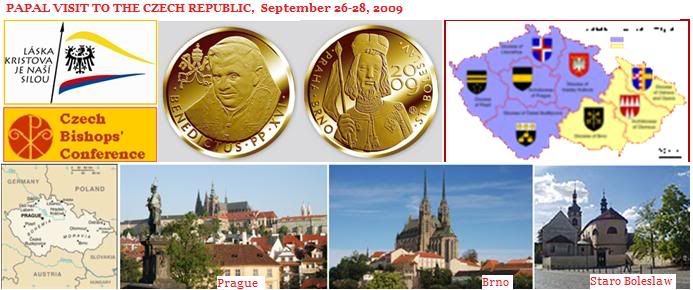 Not the least of the writing tasks for the Holy Fahter during his current vacation are the drafts for the papal texts to be delivered when he visits the Czech Republic in September. By the same token, the Church in that country is deep in preparations for the Sept. 26-28 visit. The English service of Czech Radio has a situationer:
Preparations underway
Not the least of the writing tasks for the Holy Fahter during his current vacation are the drafts for the papal texts to be delivered when he visits the Czech Republic in September. By the same token, the Church in that country is deep in preparations for the Sept. 26-28 visit. The English service of Czech Radio has a situationer:
Preparations underway
for Pope's autumn visit
By Christian Falvey

July 15, 2009
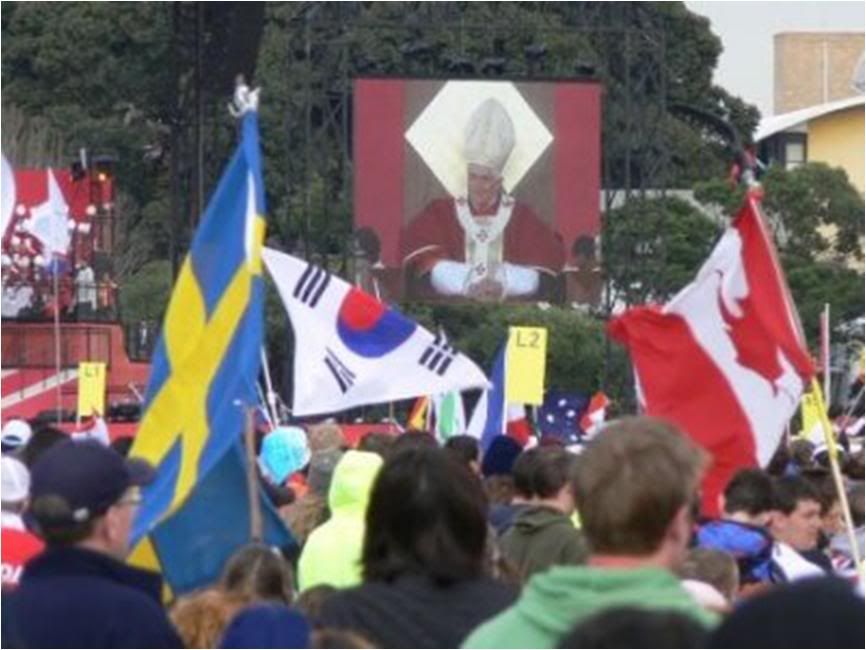
2009 is a year of big visits for the Czech Republic. After receiving the new American president Barack Obama in April, the country is now preparing for another extremely important visitor: His Holiness Pope Benedict XVI, who will be making several stops in the country over three days in September.
The papal visit from September 26 to 28 will be the first for the new pope, and preparations are already in full swing. Much of the program has been especially planned according to the Pontiff's wishes, during which he will visit the country’s main pilgrimage sites and other sites of particular interest to him.
Karel Štícha, from the office coordinating Pope Benedict’s visit, said: “The Pope will visit two important cities in the CR, first he will celebrate Holy Mass in Brno, which is the capital of Moravia, and then he will visit Stará Boleslav, a well-known city in Central Bohemia, and in this city, on the day of St. Wenceslas, he will celebrate Mass for the people from the region.”
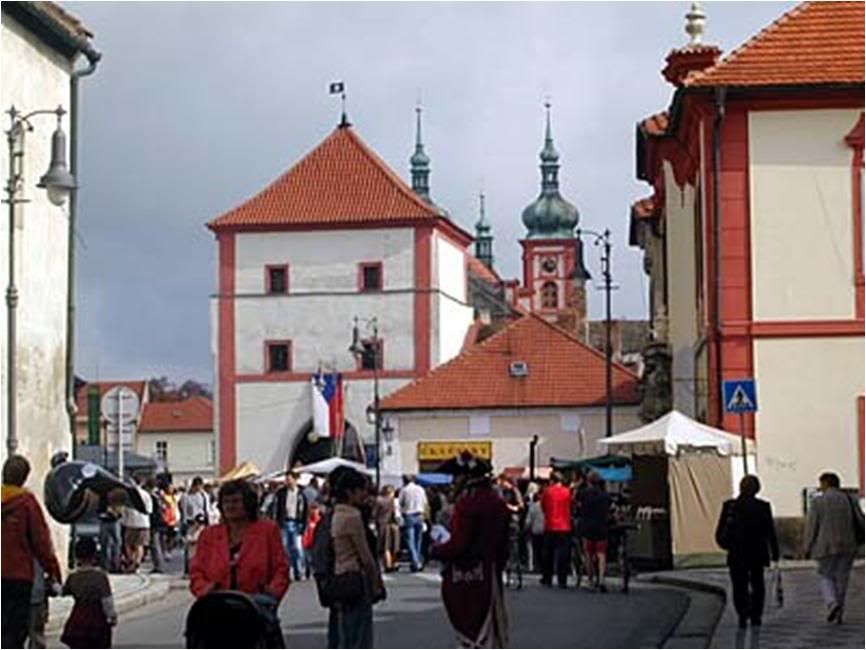
Stará Boleslav is of huge significance to Czech Catholics as it marks the site where the patron St. Václav, a.k.a. Good King Wenceslas, was murdered by his younger brother, thus dying a martyr.
This stop on Pope Benedict’s tour of the country will be a major event, with 30,000 people tentatively expected, and thus a lot of the planning is focused on international transit to and from Stará Boleslav, as well as on many other areas.
“We are in the process of negotiation with the companies that are able to construct the structures necessary to prepare for Holy mass and we are also in the process of negotiating with the state authorities about cooperation on infrastructure and the logistical preparations and so on.”
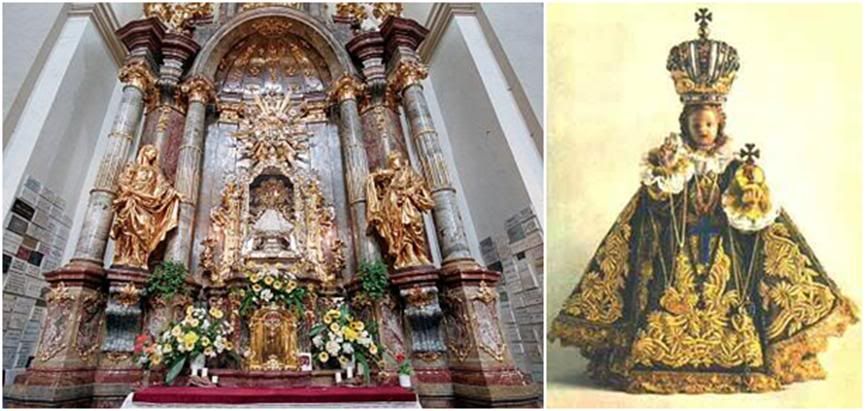
Prague, of course, will not be off the Holy Father’s list of things to see. Here, he requested a special stop at the Church of Our Lady Victorious which houses the Infant of Prague, a statue of the infant Christ that is revered around the world. Father Petr Šleich heads the Carmelite Priory of the Infant Jesus of Prague*.
[The visit to the image is the Pope;s first event in Prague after the airport arrival ceremony.]
“It’s not an honour for the Infant Jesus of Prague to be visited by the Holy Father, but in this special case it’s an honour for the Holy Father to visit the little Jesus in this place which is so widely known and beloved by so many faithful on every continent today, and for centuries already.
"I think it is a great encouragement for all those Christian people in many countries who love this image of the little Jesus, they can see that the Church really appreciates their devotion, their trust in the little Jesus, and that they are not alone in this, that even the Pope himself shares their attitude.”
The Czech Republic is a famously non-religious country, with 59% of the population agnostic, atheist or non-denominational.
Nonetheless, the roughly 2.5 million Catholics in the country will doubtless be joined this autumn by their brethren from the neighbouring Catholic bastions of Slovakia and Poland and the Pope’s homeland of Germany.
The papal visit to the Czech Republic is sure to be a big one. John Paul II visited the Czech Republic three times. [He must have felt such concern for what had become of the once very Catholic Czechs after four decades of life under Communism.]

* I have had occasion to note a couple of times in the past how widespread is the devotion to the Infant Jesus in my country, the Philippines, where he is known as the 'Santo Nino', the Spanish words for Holy Child.
And therefore, for most Filipino Catholics who can afford to travel, Prague would rank among their first three pilgrimage choices after Rome and Lourdes, precisely for the Infant Jesus of Prague.
What I did not realize till now is that the original Santo Nino venerated by Filipinos is more than a century older than the image found in Prague, though both of them were made by Spanish artisans.
Indeed, our Santo Nino - a carved wooden statue barely 12 inches high - was a gift given by Ferdinand Magellan in 1521 to the chieftain of the local tribe on Cebu, the Philippine island where he first went ashore.
The missionaraies with him managed to baptize this chieftain, his wife, and followers. The image was a gift to mark that baptism. However Magellan was eventually speared to death in an encounter with another tribe under a chieftain named Lapu-Lapu who resisted the foreigners.
The Spaniards did not return to the Philippines until 1565, and miraculously, they found the statue in a hut that had been burned during the fighting that preceded this actual colonization of the island. A church was built on the site where the statue was found, and the church has become the Minor Basilica of the Santo Nino de Cebu.
The Infant Jesus of Prague, on the other hand, was a gift to a Bohemian noblewoman from her Spanish mother. In 1648, the 19-inch-tall image was turned over to the Carmelites of the Church of Our Lady of Mary Victorious in Prague. However, it is thought that the statue may have been made as early as 1340.
In fact, the oldest continuing Santo Nino devotion is Spain's Santo Nino de Atocha (Madrid) commemorating miracles in the 13th century attributed to a little boy dressed as a pilgrim turning up to help Christians persecuted by Muslims.
The Santo Nino devotion has taken hold particularly in Latin America, and if the Philippines had not had its own older Santo Nino tradition, it would certainly have received it eventually during the three centuries of Spanish rule, when the cultural osmosis was mostly from Latin Amnerica (particularly Mexico) to the Philippines, rather than directly from Spain.
I have Googled the query but there does not seem to be any comparable Infant Jesus devotion in Germany, not even in Bavaria. The references mention St. Therese of the Child Jesus, St. Francis of Assisi, St. Anthony of Padua, and St. Teresa of Avila as devotees of the Infant Jesus.
[Modificato da TERESA BENEDETTA 16/07/2009 00:59] |
| |
 16/07/2009 00:56 16/07/2009 00:56 |
|
| | | OFFLINE | | Post: 17.951
Post: 620 | Registrato il: 28/08/2005
Registrato il: 20/01/2009 | Administratore | Utente Senior | |
|
 Day 3 in Les Combes:
Day 3 in Les Combes:
Bad weather keeps Pope indoors

LES COMBES, July 15 (Translated from ANSA) - Wholewheat bread, strudel and raspberry cake, lots of fresh home-grown veggies, and myrtle berries, raspberries and strawberries.
Benedict XVI likes good simple food with a minimum of seasoning. And he is getting the best produce that Val D'Aosta can offer.
But he also likes his desserts - and supplementing the dessert fare prepared by his Memores housekeepers is the Dupont pastry shop established in 1920 in nearby Villeneuve.
Patrizia D'Amico, who owns it, has served two Popes. "This weekend, we will bring him a thyme-and-raspberry cake, which is our summer specialty, and a simple strudel."
She adds, "We will add a card wishing him a happy vacation with us."
The Pope's daily bread comes from Arvier, another small town near Introd, from the Frassy bakery. "They come at 6:30 to pick up the order," says Ettore Frassy, the owner. "It seems the Pope likes wholewheat bread, but they also order white bread. John Paul II always asked for black bread (rye)."
"We have provided bread for the Pope since the first visit of John Paul II in 1989," he says proudly. His son Ymanc and an 18-year-old nephew help him out. "It's a great honor to be the baker to the Pope."
Since the bakery provides bread to Arvier and the surrounding area, they start working at 10:30 in the evening, preparing the dough.
Don Tomasso Scotto, housekeeper at the Don Bosco Institute of nearby Chatillon, is in charge of bringing food and other supplies daily to the Pope and the nearby Salesian vacation colony.
"I take care of all the food requirements as well as those needed for maintaining the house and grounds," he says. "I must say Papa Ratzinger has no special requests. I bring up fresh fruit and vegetables - I brought up two baskets of raspberries, myrtleberry and strawberries for the Pope just now. And of course meat, eggs and milk, cheese, wine and liqueurs, through the Pope himself does not drink alcohol."
On his second day in Les Combes on Tuesday, the pope did take an evening walk and visited one of the new features prepared for him by his Salesian hosts this year - a small cottage in the woods, where he can rest and even do some work (read and research) if he wants to.
But today bad weather did not allow the Pope to do anything outdoors.

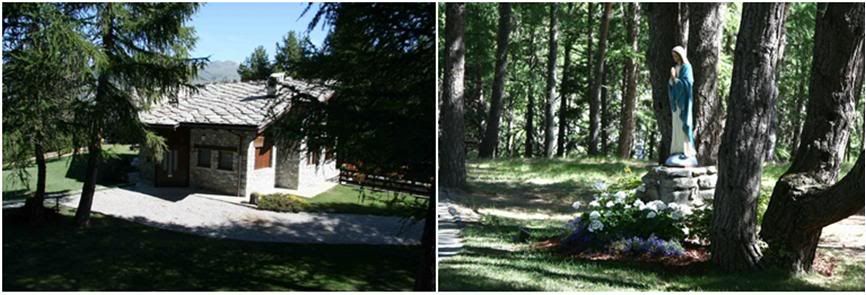 The cross fashioned out of single tree root, the statue of the Madonna, adn teh accessory chalet are new this year in Les Combes.
Home-grown veggies for Benedict -
The cross fashioned out of single tree root, the statue of the Madonna, adn teh accessory chalet are new this year in Les Combes.
Home-grown veggies for Benedict -
and next year, his own soaps and creams

LES COMBES, July 15 (Translated from Apcom) - An organic vegetable garden was started by the communal farm of Ollignan on the grounds of the Holy Father's Les Combes summer redience.
Fifteen handicapped wards of the Fondazione Ollginan from the homonymous village adjoining the local shrine of Quart, 20 kilometers from Introd, wer assigned to the garden which they have fenced off with twisted beech twigs. It has a circumference of about 70 feet,
They have salad greens of every kind; red, yellow and white onions; cabbages, and a herbarium for rosemary, thyme, basil and salvia.
The wards planted everything at Ollignan and then transplanted them in les Combes. From the communal farm itself they bring eggplants, tomatoes, zucchini and beans, as well as apricots and grapes.
Foundation director Rene Benzo said that the farm also raises calendula, a variety of marigold, which can be used as a salad green, a natural food coloring like saffron, a home remedy for burns, stings and wounds, and a source of oil for cosmetics.
He said that next year, they will be able to offer the Pope refined calendula oil as well as a line of calendula-based soap and creams.
The Foundation, founded in 1999 by a regional association of families with handicapped members in order to give employment to handicapped persons, has seven hectares of farmland, 25 beehives, a poultry, and 1,080 calendula bushes.
[Modificato da TERESA BENEDETTA 16/07/2009 01:22] |
| |
 16/07/2009 13:30 16/07/2009 13:30 |
|
| | | OFFLINE | | Post: 17.953
Post: 622 | Registrato il: 28/08/2005
Registrato il: 20/01/2009 | Administratore | Utente Senior | |
|
 Anticipating Sept. 6
Anticipating Sept. 6
papal visit to Viterbo
Translated from
the Italian service of

July 14, 2009

Mons. Lorenzo Chiarinelli, bishop of Viterbo, said he expects the visit of Pope Benedict XVI to his diocese on Sept. 6 to be 'serene and fruitful'.
He presented the diocesan plans for the Pope's welcome to the city council on Monday. Amedeo Lomonaco has a report:
The program for the Pope's visit will be shaped by the diocese's two patron saints. St. Rosa of Viterbo and St. Bonaventure of Bagnoregio, whose liturgical feast the Church observes today.
The history of Viterbo and its surroundings has been profoundly woven with the history of the Church over the centuries and with specific Pontificates. It calls itself the city of Popes because five Popes were elected there and 50 Popes have visited.
Mons. Chiarinelli said Benedict XVI's visit will favor "a reflowering of the roots of Viterbo for a fresh appreciation of its past history as a papal city".
The Pope will arrive by helicopter from Castel Gandolfo, landing at the city's sporting field, from which he will drive to the Palace of the Popes where he will give his first greeting to the citizenry. He will then proceed to the city's Faul valley to celebrate Mass and lead in the Angelus prayer.
In the afternoon, the Pope will see Viterbo's unique Macchina di Santa Rosa, an elaborate tower on which the statue of the saint is carried in a unique candlelight procession every year on Sept. 3 to commemorate the translation of her incorrupt body in 1268 from her simple grave as a Poor Clare to the Church now dedicated to her and which is the city's Cathedral.. (Rosa lived a brief life, 1233-1251, which was marked by many miraculous healings, and Viterbo believes her protection saved the city from the great pestilence of 1657.)
The 30-foot Macchina, weighing about half a ton, is carried by specially selected devotees from the Porta Romana to the Basilica of Santa Rosa through a kilometre of winding streets, up and down hill, while the lights of the city are turned off.
He will venerate the saint at the Cathedral and then proceed to the shrine of the Madonna della Quercia, where he will pray with the nuns from the cloistered orders of Viterbo.
He will then proceed to nearby Bagnoregio where he will venerate the relics of St. Bonaventure, the Seraphic Doctor, who was the subject of his habilitation dissertation in 1955. He will then address the citizens of Bagnoregio from the town square, before returning to Castel Gandolfo.
Isabella Piro spoke to Mons. Chiarinelli, who said:
"I wish for two things from this visit. One is that the Pope, who comes to confirm us in the faith, will reawaken in the hearts of everyone the need and the joy of believing. Faith, especially for the younger generations, is the energy which leads us towards the goal for which we live.
"My second wish is that it may lead to a repair of so much fragmentation in society on the level of culture, of religious experience, the economy and politics - that the sense of unity may prevail over differences, so that our society may truly be based on freedom, truth, love and justice.
"These, I hope, will be the fruits of the Pope's visit."
The bishop also spoke of St. Bonaventure's legacy:
"To live the faith in the light of the saint's theology means to walk alongside the mystery of Christ within the dynamism of changing times, sustained by hope, which is a guaranteed certainty of attaining fullness of life. We must not escape from facing the challenges of history, time, society. Bonaventure teaches us to live within our time, but with the certainty that St. Paul spoke of - we are in quest of our future homeland." (NB: Prof. Ratzinger's dissertation was about Bonaventure's theology of history).
[Modificato da TERESA BENEDETTA 16/07/2009 13:32] |
| |
 16/07/2009 14:24 16/07/2009 14:24 |
|
| | | OFFLINE | | Post: 17.954
Post: 623 | Registrato il: 28/08/2005
Registrato il: 20/01/2009 | Administratore | Utente Senior | |
|

July 16
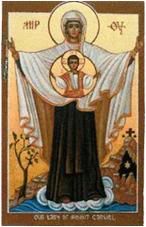 Our Lady of Mt. Carmel
Our Lady of Mt. Carmel
Patron Saint of the Carmelite Orders
OR today.
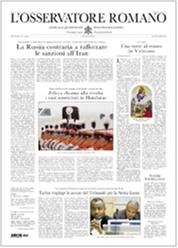 No papal stories in this issue, apart from a couple of routine episcopal nominations.
No papal stories in this issue, apart from a couple of routine episcopal nominations.
Page 1 stories; Russia opposes stronger sanctions against Iran; exiled Honduras president
calls on his supporters to revolt; former Liberian President faces the International Court
of Justice in his trial for war crimes and crimes against humanity in the neighboring country
of Sierra Leone during the 1991-2003 civil war in which he openly supported anti-government
rebels; and an editorial commentary by the director of the Vatican Museum on the initiative
for the great museums of Europe, including the Vatican Museums, to have evening hours to
accommodate local residents only, who feel crowded out of their own museums by the daytime
tourist crowds. The Vatican will try it out on July 24 from 7-11 p.m.
THE POPE IS ON VACATION - DAY 4
But even while the Pope is on vacation, the government of the Church goes on, and today,
the Vatican confirmed a few Curial nominations anticipated earlier by Andrea Tornielli of
Il Giornale. The most important changes are:
- Mons. Carlo Maria Vigano as Secretary of the Vatican Governatorate in place of
- Mons. Renato Boccardo, who has been named Archbishop of Spoleto-Norcia.
- Mons. Peter Brian Wells, till now head of the English section at the Secretariat of State,
to counselor for General Affairs, in place of
- Mons. Gabriele Caccia, who has been named Apostolic Nuncio to Lebanon.
The other nominations involve transferring a few Italian bishops from their present diocese
to another.
********
Incidental note: Rorate caeli blog yesterday cited a Spanish site Rumores de Angeles that says Andrea
Tornielli may be named to succeed Fr. Federico Lombardi as the Vatican Press Office director. He would
be very well-qualified and knowledgeable, both as a competent, reliable and objective journalist and as
the author of quite a few authoritative papal biographies (including one on Benedict XVI shortly after
the April 20-05 conclave) and other books on religion.
 Pope mourns victims
Pope mourns victims
of Iran plane crash

VATICAN CITY, JULY 16, 2009 (Zenit.org).- Benedict XVI has expressed his condolences about a plane crash in Iran that killed all 168 people on board.
The Pope affirmed this in a telegram sent through his secretary of state, Cardinal Tarcisio Bertone, after receiving the news of Wednesday's "great loss of life in the air tragedy over Jannat Abad near Qazvin."
The aircraft, a Russian model Tupolev Tu-154, was traveling from Tehran, Iran, to Yerevan, Armenia's capital, when it caught fire 16 minutes after take-off.
The Caspian Airlines flight dived into a field and exploded, sending wreckage over a 200-yard area.
The Holy Father offered "heartfelt condolences to the civil authorities and the families of the victims."
The English-language telegram, sent to the apostolic nuncio of Iran, Archbishop Jean-Paul Gobel, stated that the Pontiff "prays for the eternal repose of the dead and implores the almighty and merciful God's gifts of comfort and strength on those who mourn the loss of their loved ones."
The majority of the passengers were Iranian, many from the ethnic Armenian community.
[Modificato da TERESA BENEDETTA 17/07/2009 06:23] |
| |
 16/07/2009 17:13 16/07/2009 17:13 |
|
| | | OFFLINE | | Post: 17.955
Post: 624 | Registrato il: 28/08/2005
Registrato il: 20/01/2009 | Administratore | Utente Senior | |
|

 Pope Benedict to pay homage
Pope Benedict to pay homage
to St. Anselm on July 24
at Aosta Cathedral

AOSTA, July 16, 2009 (Translated from ANSA) - Pope Benedict XVI will pay homage to St. Anselm of Canterbury, a native of Aosta, whose ninth death centenary is being observed this year, when he visits the Cathedral of Aosta on Friday afternoon, July 24, to celebrate Vespers with the diocesan clergy=, religious and seminarians.
The Cathedral of Aosta, dedicated to the Virgin of the Assumption, recently underwent extensive restoration in preparation for the Anselmian Year (Anno Anselmiano) observed by the region of Val D'Aosta and the diocese.
An addition to the cathedral for this jubilee year is a 'Tribute to Saint Anselm' cenotaph executed by English sculptor Stephen Cox which has been set up at the southern entrance to the church.
The Pope will also use the occasion for his now-customary question-and-answer session with the diocesan clergy.
After John Paul II, who came to Aosta for a pastoral visit in 1984, Benedict XVI will be the second Pope to visit the Cathedral, which was built in the 11th century on the site of a 4th century church, and extensively remodelled in the 16th century.
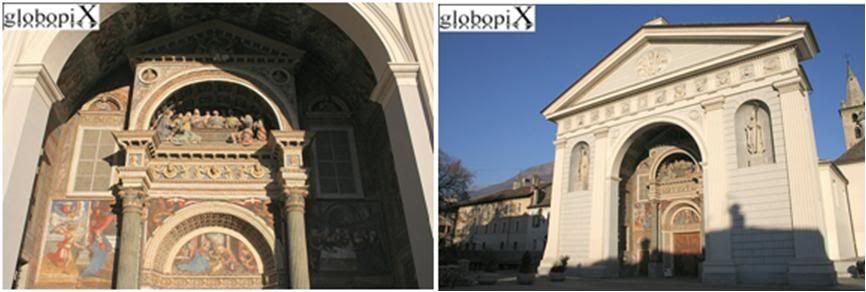
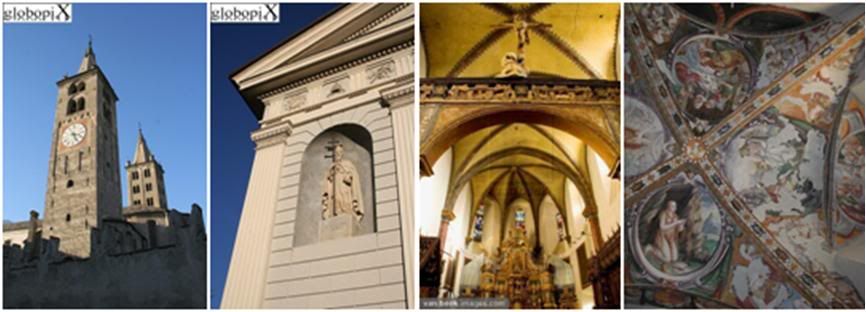 In the second picture of teh bottom panel above, St. Anselm on the left facade of the Cathedral of Aosta.
In the second picture of teh bottom panel above, St. Anselm on the left facade of the Cathedral of Aosta.
The region has planned a program of religious and cultural events to celebrate the life and thought of Anselm, one of the great medieval doctors of the Church, who was a Benedictine monk, theologian and philosopher, and to foster appreciation for the region's cultural patrimony.
P.S.  reports that the Pope will not hold a Q&A with the clergy this time. He will celebrate Vespers with them and give a homily.
[Modificato da TERESA BENEDETTA 17/07/2009 02:21] |
| |
 16/07/2009 18:43 16/07/2009 18:43 |
|
| | | OFFLINE | | Post: 17.956
Post: 625 | Registrato il: 28/08/2005
Registrato il: 20/01/2009 | Administratore | Utente Senior | |
|
 This excellent essay from a very systematic and perceptive mind deals with the ideological reflex of labelling Benedict XVI and his new encyclical according to one's personal biases, in general; about the myths created by the media and that come to be implanted in most people's minds as 'truth'; and in the concluding part, deals with George Weigel's NRO critique which this writer calls 'condescending and patronizing', as well as the menace posed by Obama's 'anti-life socialism'.
This excellent essay from a very systematic and perceptive mind deals with the ideological reflex of labelling Benedict XVI and his new encyclical according to one's personal biases, in general; about the myths created by the media and that come to be implanted in most people's minds as 'truth'; and in the concluding part, deals with George Weigel's NRO critique which this writer calls 'condescending and patronizing', as well as the menace posed by Obama's 'anti-life socialism'.
It was a most pleasant surprise to come across - easily the best common-sense general appreciation I have read so far about CIV. I hope Mr. O'Brien continues to share similar commentaries on current issues
Split in consciousness: Split in conscience -
'liberal' and 'conservative' reactions
to 'Caritas in Veritate'
by Michael D. O'Brien

July 14, 2009
As Cardinal Josef Ratzinger pointed out more than 25 years ago, the political terms “liberal” and “conservative” are grossly misleading when applied to the Kingdom of God.
They are especially so when applied to the ongoing evangelical mission of the Church, which is to draw all men to Christ, to work while the light lasts, to be a “light to the Gentiles.”
The most destructive aberrations in social and political thought of the post-war era have arisen from the application of these artificial constructs to the human community: left versus right, liberal versus conservative, neo-liberal versus neo-conservative, love versus truth, justice versus mercy, etc, etc.
These adversarial templates present to us as fact certain images that function in the mind much the same way as does myth, faith systems, and symbols.
But myths, if they are not based in reality, can create artificial dichotomies that derive from damage done to man’s concept of himself and his societies.
They alter consciousness, the psychology of perception at its very roots. And thus they alter conscience. This in turn largely determines the choices we make and the actions that come from them.
While the templates may have a strictly limited value in their particular sphere of reference, they become destructive to the degree that they displace or negate “the whole truth about Man.”
The slow mutation of the crucial templates since the end of the Cold War has not brought about the end of dehumanizing forces at work in the world. It is part of our current state of delusion to think that the fall of major Marxist regimes has ushered in a new era in which freedom largely reigns, and in which the spread of democracy has taken a leap forward in a determined historical process.
The truth is that the errors inherent in all forms of Materialism, including Marxism, varieties of Socialism, and certain kinds of exploitive Capitalism, have now spread throughout the world as the great leveler and engine of societies.
Theocratic tyrannies (radical Islamicism being the most obvious) are a different category, yet they and the Materialist societies have one thing in common, and it is a decisive thing, a most deadly thing: In their anthropology and practice, each in their way minimalize, where they do not negate altogether, the value of man — every man, any man from conception to natural death.
Pope Benedict’s stunning new encyclical cuts across all ideological lines, calling all mankind to an examination of conscience regarding our fundamental approach to the meaning of the human person.
He does not speak about mankind in the abstract, not as “the masses”, not as geopolitical statistics or economic utilities, but as the entire community of human beings in this world, each possessing inherent rights and duties. We are, he says, “the Family of Man.”
Thus, the encyclical challenges human enterprises of every sort to see farther and deeper than we have until now, to understand that the development of a truly human world can only be based in solidarity with all members of the community: “The truth of development consists in its completeness: if it does not involve the whole man and every man, it is not true development.” (C in V, n. 18)
The Pope warns that globalization’s principle new feature, the “explosion of worldwide interdependence,” presents colossal risks, for “without the guidance of charity in truth, this global force could cause unprecedented damage and create new divisions within the human family.” (C in V, n. 33).
To summarize the rich material in this encyclical is a daunting task; indeed it can be properly understood only with careful study and reflection.
Yet in essence the Pope is critiquing every form of governance, economics, and culture that denies the humanity of some human beings, be they the pre-birth child or the aged and infirm, or the poor in underdeveloped countries, in fact anyone.
For East and West, North and South, an examination of conscience is urgently needed if we hope to avoid the proliferation of untold human misery and historical disasters.
Paramount in the affluent nations will be a radical self-examination of its economics, because, as the Pope notes emphatically: “every economic decision has a moral consequence” (C in V, n. 37), and in the global age every such decision has both a personal and a universal consequence.
The encyclical is not only a warning; it is an exhortation to mankind to employ all our vast material resources and intelligence, motivation and imagination, to develop new forms of interaction, commerce, culture, communication that would lead toward genuine progress and communion.
The splits in Western consciousness are evident in the extraordinary negative reaction to the encyclical that has erupted in so-called liberal and conservative circles.
The liberal approach has been to extract from the encyclical the Pope’s words regarding the rights of the poor, the worker, and the underdeveloped nations, while ignoring what he says about the rights of the unborn child.
The recent scandal involving the Canadian Catholic Conference of Bishops’ social justice arm, Development and Peace, is a case in point.
Extensive documented evidence has proved that D&P has been funding organizations that promote abortion rights as part of their agendas in several nations in Latin America, Africa and Asia.
In East Timor, for example, that country’s Catholic bishops have struggled with great effort to resist the liberalization of the abortion law, and two of their leading opponents have been pro-abortion feminist organizations funded by the national conference of the bishops of Canada.
The bishops’ conference of Peru recently sent a letter requesting the bishops of Canada to cease funding pro-abortion organizations in their country.
Executives of the CCCB and D&P simply could not understand the problem; could not see that sending money to “help the poor” was enabling the destruction of some of the poor.
Here is a symptomatic split in consciousness and consequent blurring of conscience, which is the result of reducing the Gospel to one dimension only.
The split has enabled spokesmen for the CCCB and D&P to exonerate themselves by conducting a limited in-house “investigation” that resulted in a report which flies in the face of the overwhelming evidence. Yet, despite their “findings,” the objective facts remain: the money of good-willed Catholics in Canada is enabling the spread of the “culture of death.”
The conference’s extraordinary over-kill reaction against news services that reported the scandal is classic damage control, spin doctoring, verbal smoke and mirrors. It bears repeating that the facts are incontrovertible and visible in the naked public square for all to see.
Adding insult to injury, some Catholic periodicals in this country, after a selective reading of Caritas in Veritate, have declared that the encyclical roundly vindicates the policies of Canada’s D&P.
If a passage in the Pope’s writings seems to confirm their template, then it is extracted out of context and the rest of the Holy Father’s teachings are ignored. Little or no heed is paid to his repeated exhortations regarding the right to life, which he underlines in passages such as this:
If there is a lack of respect for the right to life and to a natural death, if human conception, gestation, and birth are made artificial, if human embryos are sacrificed to research, the conscience of society ends up losing the concept of human ecology, and, along with it, that of environmental ecology…
It would be wrong to uphold one set of duties while trampling on the other. Herein lies a grave contradiction in our mentality and our practice today; one which demeans the person, disrupts the environment and damages society. (n. 51)
In his 1984 interview with Vittorio Messori, The Ratzinger Report, the cardinal, who was then Prefect of the Congregation for the Doctrine of the Faith, discussed the potential dangers in the rise of national bishops’ conferences.
He warned that they were vulnerable to manipulation through their “democratic” processes, too easily commandeered by factions with limited sociopolitical and/or flawed ecclesiological agendas. [The most egregious examples of these are the bishops' conferences of Germany and Austria, and perhaps Belgium, the Netherlands and France.]
That is what has unfolded in some affluent nations, Canada and Germany being among the more notable examples. If this sort of ecclesiology posits a national bishops’ conference as a kind of functioning “alternative magisterium,” it will pay lip service to the office of the Pope, then go about its day to day business pretty much as it pleases, despite the fact that as a body it has no canonical authority over the faith of Catholics.
[And that is what has been happening in effect. The creation of national bishops' conferences by Vatican-II has blinded the ego-driven among the bishops to ignore everything else that Vatican-II has to say about the authority of the Pope in the universla Church, the relationship of bishops to the Pope and the obedience that they owe him.]
In genuine ecclesiology, individual bishops exercise their office authentically when they are in full union with “Peter”, with the whole mind of the Church, the Mind of Christ.
In Canada, the national bishops’ conference has quietly functioned in another way for the past several decades, sometimes ignoring directives from Rome, sometimes openly pushing contradictory programs, relentlessly and “nicely”, which is our national norm.
In contrast, several individual bishops in this country have lived the authentic ecclesiology, have heroically and apostolically shepherded the flocks in their dioceses, and have been highly visible in the pro-life movement. Though they are a minority, their numbers are increasing despite the counter-witness of the national conference.
In its social justice policies the CCCB has until very recently been disproportionately weak on the rights of the unborn child and the rights of the family. In its primary social justice arm, Development and Peace, it has ignored the right to life.
D&P’s stated policy is mainly focused on the “preferential option for the poor,” which it has at times interpreted to mean softer forms of socialist thinking.
While it has rightly donated vast sums of money to relieve natural disasters in the underdeveloped nations, and also promoted legitimate development projects, it has frequently lacked careful discernment. It has especially lacked understanding of the integral relationship between love and truth.
Benedict points out that, “Without truth, charity degenerates into sentimentality. Love becomes an empty shell to be filled in an arbitrary way.” (n. 3)
He further points out that human rights cannot be compartmentalized: “The right to food, like the right to water, has an important place within the pursuit of other rights, beginning with the fundamental right to life.” (n. 27)
It should be noted that the compartmentalized compassion of D&P once prompted it to fund a Marxist revolutionary group in Brazil, a fact documented by the journalist Elaine Dewar in her 1994 study of environmentalist movements, Cloak of Green.
The incident was doubtless an isolated error in judgment, and of course the bishops of Canada do not endorse Marxism. However, as a body they have permitted themselves to be used for other forms of social revolution that do not respect the lives of all the poor, including those poor who are living in the womb. It is precisely this kind of double standard that Caritas in Veritate addresses.
Not all such selectivity is from the “liberal” mind-set. American Catholic “neo-conservatives” have also been guilty of it, though their approach is usually more carefully articulated, subtly argued.
With the publication of Caritas in Veritate, articles appeared on neo-conservative websites “explaining” the encyclical, minimizing its significance, calling into question its authoritative voice in the formation of conscience.
Doubtless, the major flagship journals of American neo-conservatism will be busy about damage control for some time to come, fragmenting and nuancing and explaining away what ought not be explained away, what should be reflected upon and acted upon with very close attention to the wisdom in the letter.
A case in point is George Weigel’s response, which appeared within days of the encyclical’s publication. Weigel enjoys immense influence over the thinking of educated, doctrinally orthodox Catholics in America and abroad. Moreover, his biography of John Paul II is considered by many to be the definitive one.
In Witness to Hope, Weigel wrote that John Paul II’s social encyclical Centesimus Annus did not attempt to outline a “free economy” but instead explored the question of how one should use a free economy, and how it contributes to the economic common good and serves the human good.
He also fairly quotes John Paul II regarding the dangers of any form of capitalism that “is not circumscribed within a strong juridical framework which places it at the service of human freedom in its totality and sees it as a particular aspect of that freedom, the core of which is ethical and religious....” (CA, 42.1 - 42.2). In this section of the biography Weigel reveals his well-developed knowledge of Catholic social teaching.
One would have expected, therefore, a similar open approach to Pope Benedict’s encyclical, which builds upon the personalist foundation of Centesimus Annus and also upon Paul VI’s Populorum Progressio (on the development of peoples), as well as on the previous major social encyclicals.
In a July 7th article titled, “Caritas in Veritate — The revenge of Justice and Peace (or so they may think)", Weigel described the new encyclical as:
… a hybrid, blending the Pope’s own insightful thinking on the social order with elements of the Justice and Peace approach to Catholic social doctrine. [Weigel is referring to the Pontifical Council for Justice and Peace, not to the Canadian bishops’ organization Development and Peace...]
Indeed, those with advanced degrees in Vaticanology could easily go through the text of Caritas in Veritate, highlighting those passages that are obviously Benedictine with a gold marker and those that reflect current Justice and Peace default positions with a red marker. The net result is, with respect, an encyclical that resembles a duck-billed platypus.
The clearly Benedictine passages in Caritas in Veritate follow and develop the line of John Paul II, particularly in the new encyclical’s strong emphasis on the life issues (abortion, euthanasia, embryo-destructive stem-cell research) as social-justice issues — which Benedict cleverly extends to the discussion of environmental questions, suggesting as he does that people who don’t care much about unborn children are unlikely to make serious contributions to a human ecology that takes care of the natural world.
The encyclical rightly, if gingerly, suggests that thug-governments in the Third World have more to do with poverty and hunger than a lack of international development aid; recognizes that catastrophically low birth rates are creating serious global economic problems; sharply criticizes international aid programs tied to mandatory contraception and the provision of ‘reproductive health services’ (the U.N. euphemism for abortion-on-demand); and neatly ties religious freedom to economic development.
But then there are those passages to be marked in red — the passages that reflect Justice and Peace ideas and approaches that Benedict evidently believed he had to try and accommodate. Some of these are simply incomprehensible, as when the encyclical states that defeating Third World poverty and underdevelopment requires a ‘necessary openness, in a world context, to forms of economic activity marked by quotas of gratuitousness and communion.’
This may mean something interesting; it may mean something naïve or dumb. But, on its face, it is virtually impossible to know what it means.
Perhaps Mr. Weigel did not give it enough time. Perhaps when he reacted so precipitously he was functioning on an a priori conviction, his personal template.
The passage he quotes is not so hard to understand: In the context of the section, the Pope is saying that human commerce must not be monopolized by or reduced to rigid economic models based only on profit; that a truly human approach to economy would always leave much room for generosity that would lead to genuine solidarity between peoples, with resulting development and benefits for all. (see n. 21, n. 25-26, n. 28, and n. 34)
The presence of irritable unwarranted phrases in Weigel’s commentary is symptomatic of something; it may mean something naïve or dumb, but on the face of it, it is impossible to know what exactly Mr. Weigel means. At the very least one can guess that he is not happy about this encyclical. He does not find it helpful. But helpful to what and to whom?
He concludes:
Benedict XVI, a truly gentle soul, may have thought it necessary to include in his encyclical these multiple off-notes, in order to maintain the peace within his curial household.
Those with eyes to see and ears to hear will concentrate their attention, in reading Caritas in Veritate, on those parts of the encyclical that are clearly Benedictine, including the Pope’s trademark defense of the necessary conjunction of faith and reason and his extension of John Paul II’s signature theme — that all social issues, including political and economic questions, are ultimately questions of the nature of the human person.
A nod towards Benedict’s gifts does not ease the overall effect of Weigel’s critique. It is, in fact, condescending and patronizing.
How does he know that the encyclical is a “duck-billed platypus” made to placate in-house tensions at the Vatican?
Perhaps he has not considered the possibility that the Pope actually believes what he is writing, and is opening up the paradigms, cracking the templates, expanding the range of vision and dialogue so that something more truly just and humane may develop, may have what he calls “breathing-space” in the current world situation.
As it stands, Mr. Weigel has said, in effect, “We love Papa, he is a sweet old soul. He is very good on religion but, alas, muddled on economics.”
It brings to mind the objections that arose after the publication of Centesimus Annus in 1991. From numerous neoconservative commentators we heard, “Oh, yes, John Paul II is a great personalist, a great pope, but, well, he is no economist.”
Correct. He was no economist. And Benedict is no economist. Neither was Paul VI nor John XXIII, nor Pius XI nor Leo XIII.
But they were men of vast understanding, and they expressed the Mind of Christ on these matters in terms of first principles, the context in which truly human economies can develop.
So let’s put our coloured editorial pens back into the inkwells for a bit, and let’s give it time and give it thought — especially let all men of good will engage their rational intellects with the spirit of humility, and see if there is something to be learned from the Vicar of Christ — something new and yet something old because it is something eternal.
Caritas in Veritate is lucid, anointed, prophetic. It is a sign of contradiction, a challenge to every system of government and economics. It is a call to truth and charity for all human beings. Minimizing the real import of this encyclical is symptomatic of perceptual as well as intellectual difficulties.
The monsters of history are real enough and obvious enough, but it is not the purpose of the encyclical to tell us that they are bad. We all know very well that they are bad news for mankind.
However, if we do not do what Caritas in Veritate asks of us, that is, to examine our own consciences, we will continue to live as we have been for centuries, lurching from crisis to crisis, economic, political and military, often grasping at hasty solutions that have enormous human cost, stumbling again and again as we choose evil to defeat evil, and all the while growing ever more hollow.
We in the West must identify within ourselves the root cause of our dissociation from reality. This will be difficult for two reasons: first, our myth about ourselves:
- First, wer ourselves the world’s idealists who are also realists, masters of Realpolitik in terms of finance and geopolitics; and
- Scond, the United States of America now faces a prodigious menace in its newly elected President.
Both are grave factors that can prevent us from breaking through the walls erected by the psychology of self-perception.
The Obama presidency did not result from any tactical failure of conservativism nor from an inexorable ascendancy of liberal socialism. It came directly from the bifurcation of consciousness, the inhuman, artificial segregation of private morality from public life.
Cutting across all party lines, it trips us up at every turn, liberal and conservative alike, because at the root is an unwillingness to sacrifice one’s career and one’s security, if need be, to defend first principles. This should lead us to the deeper question: where did the bifurcation come from?
It will be tempting for Americans to revert to their own “default position”, their traditional either/or choice, to presume that Obama’s anti-life socialist revolution can be overturned at the next election by a big swing toward neoconservatism, after which, presumably, the nation will get back to business as usual.
This would be a step in the right direction, but it will not touch the core problem. To perceive such a turn of political events as a restoration to health would be to mistake the disease for the cause of the disease.
If our domestic “freedoms” must be preserved by the murder of innocent human beings within our borders (abortion and euthanasia), and if our prosperity must be preserved by the dehumanization and/or deaths of other human beings outside our borders (abstracted, mere statistics, collateral damage), then we must ask ourselves if our current way of life has dehumanized us, as well as dehumanizing those who pay with their lives for our public policies.
Have we truly looked deeply into the Utilitarianism which rules us? Have we succumbed to the falsehood that economics is an entirely independent category of human enterprise with its own laws, principles, and exigencies that take precedence over the transcendent value of man, as long as it is done in the name of a vaguely defined “common good”?
Pope Benedict XVI teaches us that anything other than the whole good, the “common good of mankind,” is a tragically stunted myth of the good:
God's love calls us to move beyond the limited and the ephemeral, it gives us the courage to continue seeking and working for the benefit of all, even if this cannot be achieved immediately and if what we are able to achieve, alongside political authorities and those working in the field of economics, is always less than we might wish. God gives us the strength to fight and to suffer for love of the common good, because he is our All, our greatest hope.
Development needs Christians with their arms raised towards God in prayer, Christians moved by the knowledge that truth-filled love, caritas in veritate, from which authentic development proceeds, is not produced by us, but given to us.
For this reason, even in the most difficult and complex times, besides recognizing what is happening, we must above all else turn to God’s love.
Development requires attention to the spiritual life, a serious consideration of the experiences of trust in God, spiritual fellowship in Christ, reliance upon God’s providence and mercy, love and forgiveness, self-denial, acceptance of others, justice and peace. All this is essential if “hearts of stone” are to be transformed into “hearts of flesh” (Ezek 36:26), rendering life on earth “divine” and thus more worthy of humanity.
All this is of man, because man is the subject of his own existence; and at the same time it is of God, because God is at the beginning and end of all that is good, all that leads to salvation: “the world or life or death or the present or the future, all are yours; and you are Christ’s; and Christ is God’s” (1 Cor 3:22-23).
Christians long for the entire human family to call upon God as “Our Father!” In union with the only-begotten Son, may all people learn to pray to the Father and to ask him, in the words that Jesus himself taught us, for the grace to glorify him by living according to his will, to receive the daily bread that we need, to be understanding and generous towards our debtors, not to be tempted beyond our limits, and to be delivered from evil (cf. Mt 6:9-13). [Caritas in Veritate, n. 78-79]
I will not do justice to Mr. O'Brien by a two-line reduction of his CV, which may be found on
ignatiusinsight.com/authors/michaelobrien.asp
[Modificato da TERESA BENEDETTA 16/07/2009 18:45] |
| |
 16/07/2009 20:06 16/07/2009 20:06 |
|
| | | OFFLINE | | Post: 17.957
Post: 626 | Registrato il: 28/08/2005
Registrato il: 20/01/2009 | Administratore | Utente Senior | |
|
 I must check if it is customary for the President of Italy to write the Pope about an encyclical, but if it is not, this is yet another indication of the personal rapport between the Pope and the ex-Communist President of Italy, an octogenarian like him.
Italian President writes the Pope
I must check if it is customary for the President of Italy to write the Pope about an encyclical, but if it is not, this is yet another indication of the personal rapport between the Pope and the ex-Communist President of Italy, an octogenarian like him.
Italian President writes the Pope
to commend 'Caritas in veritate'
Translated from the Quirinale website

I read with great interest your third encyclical Caritas in veritate which, addressed as well to 'all men of good will;, carries your message into a society where, these years, there is apprehension and uncertainty, not only about prospects for the future of the world economy and development, but also for the changes that are taking place in human relationships, in the workplace and in business, as well as in the relations among the inhabitants of the planet, the environment and natural resources which had been for a long time considered inexhaustible.
I am sure that tehecentral themes about the life of man in relation to his fellow human beings and the great questions that concern our society - just as you outlined in your encyclical and linked so clearly and visibly in your text - will constitute a stimulus to reflections that could be beneficial for everyone.
The affirmation by Your Holiness that today the social question has become radically an anthropological question constitutes, in effect, an invitation to a profound and calm rethinking of many aspects of life and the functioning of human communities, with particular reference to the "meaning of the economy and its real ends" and to the need for a "profound and far-seeing review of the model of development in order to correct its dysfunctions and distortions".
I am pleased to take this occasion, Holiness, to reiterate the expression of my highest consideration and my attentive participation in following the daily execution of your extremely demanding mission.
Rome, July 16, 2009
GIORGIO NAPOLITANO
[Modificato da TERESA BENEDETTA 16/07/2009 20:32] |
| |
 17/07/2009 00:19 17/07/2009 00:19 |
|
| | | OFFLINE | | Post: 17.958
Post: 627 | Registrato il: 28/08/2005
Registrato il: 20/01/2009 | Administratore | Utente Senior | |
|

 Great media interest in
Great media interest in
the Pope's Canavese Angelus
by Marco Campagnolo
Translated from
an Ivrea news portal

July 16, 2009

IVREA - Everyone is pleased in the diocesan Curia, starting with Bishop Arrigo Miglio, about the media coverage anticipated for the Pope's visit on Sunday to lead the Angelus at Piazza Ruggia in nearby Romano Canavese.
No one expected th4 number of requests for media accreditation received by the diocese for a visit that is not official.
Yesterday, diocesan press spokesman Don Stefano Fogliato said that part of the media requests come from other European countries and Latin America.
On television, it will be covered by 6 national TV channels, including one from Eastern Europe, three satellite TV outlets, the regional TV of both Piedmont and Val D'Aosta, and two Ivrean channels.
Thirteen news agencies, including ones from France, Germany, the United Kingdom, Poland and Mexico, have also accredited reporters and photographers, aside form the national and regional newspapers and magazines.
 Left, Mons. Miglio with Cardinal Bertone; right, map shows location of Romano Canavese in relation to Les Combes. Turin is 40 miles to the south, Milan 80 miles to the east.
Left, Mons. Miglio with Cardinal Bertone; right, map shows location of Romano Canavese in relation to Les Combes. Turin is 40 miles to the south, Milan 80 miles to the east.
Mons. Miglio opened the news conference by saying, "The Pope has given us a gift by coming to us during his vacation, and he is doing this as a sign of his friendship and esteem for our Cardinal Bertone [who was born in Romano Canavese). He has worked with Cardinal Ratzinger since 1988. Being called to become Secretary of State confirmed the esteem that the Holy Father has for him. The visit to Romano is a visit to Bertone and to his roots, and a sign of affection for him and his townspeople".
To accommodate overflow from Piazza Ruggia in front of the parish church, jumbo TV screens will be set up in other places like Piazza Sarti, where the Bertone family residence is located, and which the Pope will be visiting; and in the parish churches of Strambino and Scarmagno.
The Pope will arrive by helicopter and will proceed to Piazza Ruggia by Popemobile through eight of the town's main streets.
The Pope's Angelus will be preceded by Mass celebrated in Piazza Ruggia by Cardinal Bertone and Bishop Miglio.
Parking has been provided by the commune in two designated places on the town periphery. Shuttle buses will take pilgrims to the center of town.
Information for those interested about the papal visit to Romano Canavese are available on the diocesan site
www.ivrea.chiesacattolica.it.
[Modificato da TERESA BENEDETTA 17/07/2009 06:05] |
| |
 17/07/2009 11:47 17/07/2009 11:47 |
|
| | | OFFLINE | | Post: 17.961
Post: 630 | Registrato il: 28/08/2005
Registrato il: 20/01/2009 | Administratore | Utente Senior | |
|

July 17
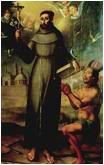 St. Francis Solano (b. Spain 1549, d. Peru 1610)
St. Francis Solano (b. Spain 1549, d. Peru 1610)
Franciscan missionary
'Wonder Worker of the New World
OR today.
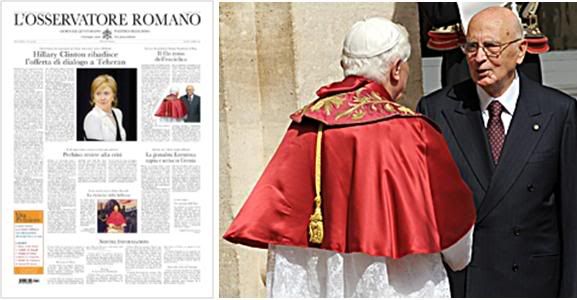
The only papal story in this issue is Italian President Napolitano;s letter to the Holy Father about his
third encyclical (full letter translated on this page yesterday) and the announcements of new nominations
and retirements yesterday. Search me why the OR should consider a routine Hillary Clinton speech to
foreign policy wonks significant enough to merit their main headline and a picture larger than the Pope's -
she reiterated the US offer to negotiate with Iran over the nuclear arms program but says the window
of opportunity cannot be kept open infinitely; China reports a 7.9% increase in its GDP for the second
quarter of 2009, more than the 7,5% anticipated - and probably the only world economy that has grown
during this recession; and Israeli says it has successfully tested a defense system called 'Iron Dome'
against short-range missiles like those Hamas uses against Israeli towns.
THE POPE ON VACATION - DAY 5
[Modificato da TERESA BENEDETTA 17/07/2009 14:49] |
| |
 17/07/2009 14:48 17/07/2009 14:48 |
|
| | | OFFLINE | | Post: 17.963
Post: 631 | Registrato il: 28/08/2005
Registrato il: 20/01/2009 | Administratore | Utente Senior | |
|
 Deo gratias! Thank the Lord it wasn't anything serious, but I must remember to add a special prayer to Papino's guardian angel every day. He has the prayers of the faithful 'faithful' - laity and clergy alike - in any case, whether they know about this incident or not, but just as there can never be too much love, there can never be too many prayers, so pray on.
Vacation Day 5:
Deo gratias! Thank the Lord it wasn't anything serious, but I must remember to add a special prayer to Papino's guardian angel every day. He has the prayers of the faithful 'faithful' - laity and clergy alike - in any case, whether they know about this incident or not, but just as there can never be too much love, there can never be too many prayers, so pray on.
Vacation Day 5:
Pope slips and has a slight fracture
of the right wrist
 VATICAN CITY, July 17 (Translated from ASCA) - "After falling down in his own room last night" at his summer residence in Les Combes where he is on vacation, Pope Benedict XVI "suffered a slight fracture of the right wrist", according to Fr. Federico Lombardi, Vatican press director.
VATICAN CITY, July 17 (Translated from ASCA) - "After falling down in his own room last night" at his summer residence in Les Combes where he is on vacation, Pope Benedict XVI "suffered a slight fracture of the right wrist", according to Fr. Federico Lombardi, Vatican press director.
"The Holy Father," he said, "nonetheless celebrated Mass and had breakfast, after which he was taken to the hospital in Aosta where the fracture was diagnosed and the wrist was immobilized". [Probably placed in a cast. And a slight fracture may mean he did not actually break any bone, but a wristbone could have shown some damage like a hairline crack on X-ray.].
P.S. Translated from
the official bulletin:

After falling in his room last night, the Holy Father has sustained a slight fracture of the right wrist.
Nonetheless the Holy Father celebrated Mass in the morning and hand breakfast, after which he was taken to the hospital in Aosta where he was diagnosed with a slight fracture, and doctors proceeded to immobilize the wrist.
 has been reporting the same thing.
Photos taken outside the hospital this morning.
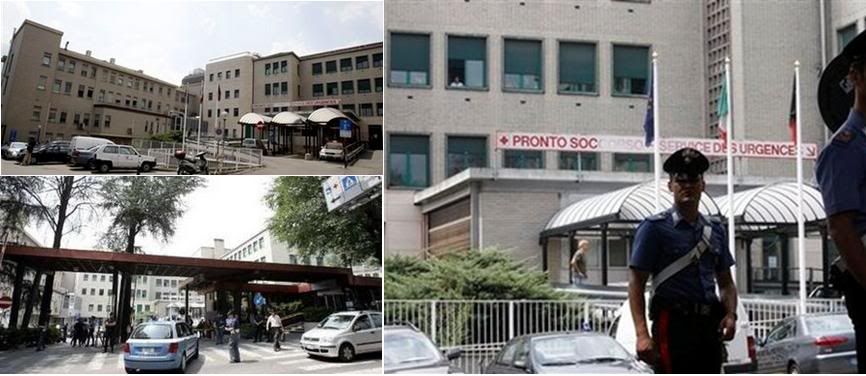 Earlier reports said he arrived at the hospital in Aosta around 9:45 a.m. (also reported by RV) accompanied by Mons. Gaenswein. The Pope's hand was X-rayed, after which he was kept under observation for 2-3 hours, as the doctors decided on the best way to manage the injury.
I always keep the TV on Fox News before I go to bed, and around 4:30 a.m. I was awakened by hearing the words 'Pope Benedict' and 'hospital'. And sure enough, it was a news alert that the Pope had been brought to the emergency room and that he had suffered a fall but there were no details as yet.
Earlier reports said he arrived at the hospital in Aosta around 9:45 a.m. (also reported by RV) accompanied by Mons. Gaenswein. The Pope's hand was X-rayed, after which he was kept under observation for 2-3 hours, as the doctors decided on the best way to manage the injury.
I always keep the TV on Fox News before I go to bed, and around 4:30 a.m. I was awakened by hearing the words 'Pope Benedict' and 'hospital'. And sure enough, it was a news alert that the Pope had been brought to the emergency room and that he had suffered a fall but there were no details as yet.
Greg Burke came on from Rome to say the latest unconfirmed report was that the Pope had broken his wrist, but that he was seen walking into the hospital so it could not have been serious. By which time I was at my PC checking out Lella's blog first, where the latest post was the ASCA item I translated above, around 11 a.m. Italian time.
It will be recalled that in 1991, the then Cardinal Ratzinger slipped in the bathroom while on vacation in Bressanone and hit his head on the radiator. He was hospitalized for a head cut and a slight concussion - and was it then that they thought he might have had a slight stroke? In any case, a friend later remarked that the radiator broke, whereas the cardinal only got away with a cut!
As Aosta is only 20 kilometers way from Les Combes, the Pope may not even have had to use the helicopter that is on standby for any contingency.
But if his right wrist is in a cast, he won't be able to do any writing for a few days - or longer! Maybe he will dictate to GG who can transcribe directly into a PC. Worse, he won't be able to play the piano.
Did he have his doctors on hand at Les Combes? One Italian report says that his cardiologist (Dr. Polisca?) had checked him out last night, presumably after the incident, and he must have found everything fine - as far as any possible cardiovascular incident - if they all waited until after Mass and breakfast the next day to go to the hospital.
Here is the AP's first report:
Pope fractures wrist in fall

VATICAN CITY, July 17 (AP) – Hospital officials and the Vatican say Pope Benedict XVI broke his right wrist in a fall during his vacation in the Alps.
Tiziano Trevisan, a spokesman at the Umberto Parini hospital in Aosta, told the Associated Press, "The Pope will be held for a few hours as the doctors treat his fracture. He will then stay for observation."
Trevisan said doctors had taken an X-ray of the Pope's right wrist and found a small fracture. The Pope is 82 and has been healthy during his five-year pontificate.
Vatican spokesman the Rev. Federico Lombardi said earlier that Benedict "slipped and got hurt" but "it doesn't seem to be serious."
Lombardi said the Pope went to the hospital in Aosta for an examination after the accident.
Just to keep things in perspective:

There are quite a few bones in the wrist area, and the most common injury is a hairline fracture to
one of those small bones (left photo), which can happen when one uses the hand to break a fall; or
it can break on the arm bone itself (right photo shows an actual break, though it could also be
a hairline crack) which does not seem to have been the case with the Holy Father.
P.S. Now ANSA reports a 'surgical reduction' of the fracture, but the AP says hospital personnel could not confirm that.
If there is such an intervention, the injury could be more than just a hairline fracture, because to reduce a fracture means to properly realign the broken parts of a bone before putting the body part in a cast. Usually this can be done by simple manipulation, and then immobilizing the wrist in a cast, but if surgery is needed, it may simply mean placing a pin to keep the bone parts together - a decision that has also has to do with the fact that the Pope uses his right hand a lot to write, so reinforcement is advisable.
AGI has more upbeat news meanwhile:
Pope is smiling, serene -
and apologizes for the 'fuss'

AOSTA, July 17 (Translated from AGI) - Smiling and serene, quick to jest about the 'trouble' he is in, and obedient to what the doctors tell him.
That is how personnel at the Umberto Farini Hospital have described the Pope who is in a private ward of the emergency room to receive medical attention for a broken right wrist.
They say he did not appear concerned and even apologized for the 'fuss' he was causing unwillingly.
It does not seem that his vacation schedule will be affected by the incident.
And a formal confirmation of the surgery - they did put two pins in:
Hospital confirms surgery
under local anesthesia

AOSTA, July 17 (Translated from various ANSA reports ) - The hospital in Aosta has officially confirmed that the Pope underwent surgical reduction of the fracture in his right wrist. It was done under local anesthesia.
It involved applying traction on the fracture and inserting two pins to secure the bone.
A hospital spokesman told newsmen that 'normal procedure' was followed for the reduction, "inasmuch as the Pope is in generally good condition."
Earlier reported:
When he arrived at the hospital in Aosta this morning, Pope Benedict XVI asked to be treated like other patients, and it was learned that we waited his turn both for his wrist X-ray and for an operating room when it was decided to undertake a surgical reduction of his wrist fracture.
Preceding him in surgery was a patient treated for acute peritonitis.

The Vatican has released these two new photos of the Pope at Les Combes, the first since he arrived there on Monday:
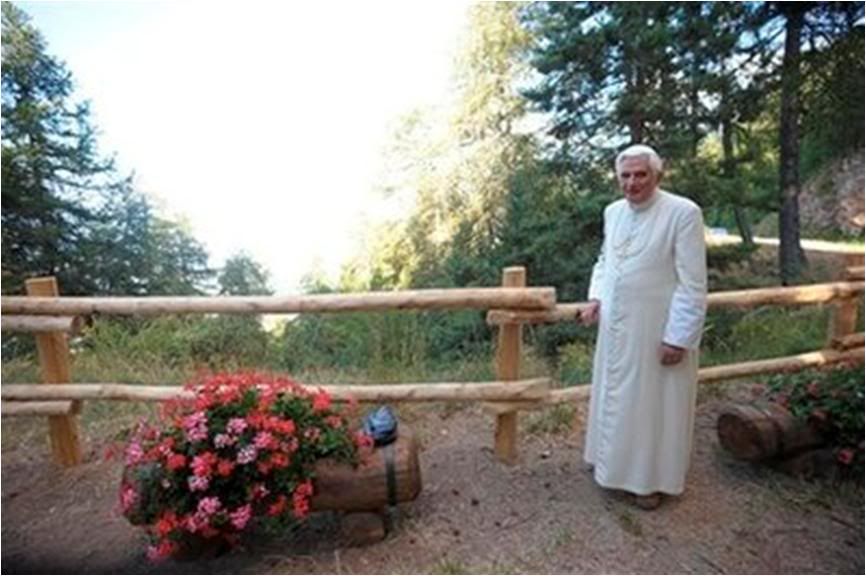
 The Pope's concession to informality while on vacation seems to be not wearing the papal capelet and sash, so he is just dressed in his cassock, without the pectoral cross. If he were in the tropics, where priests wear white, he would be walking about like any ordinary priest - unless he wears his zucchetto.
Bone surgeon says Pope's wrist
The Pope's concession to informality while on vacation seems to be not wearing the papal capelet and sash, so he is just dressed in his cassock, without the pectoral cross. If he were in the tropics, where priests wear white, he would be walking about like any ordinary priest - unless he wears his zucchetto.
Bone surgeon says Pope's wrist
should fully heal in a month -
and he can play the piano again

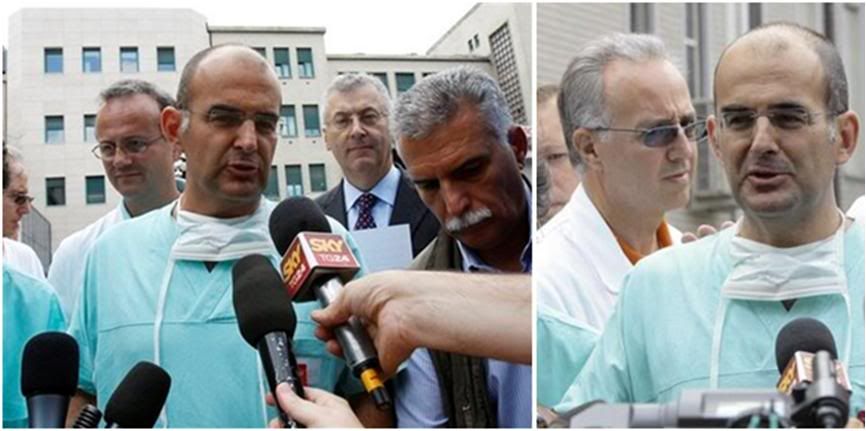
AOSTA, July 17 (Translated from AGI) - Everything went well in the treatment of the Pope's broken wrist, and it should be fully healed in a month, according to Professor Amedeo Mancini, chief orthopedist at the Perini Hospital here.
He explained that the Pope underwent a 'closed' surgery - no cuts were made.
"The bone was realigned by traction, and a trepan [sort of medical drill] was used to insert two metal pins to hold the bone in place. Then, we put a resin cast to immobilize the wrist - it serves the same purpose as a plaster cast [probably lighter and less cumbersome]. The Pope will have to keep it on for 30 days."
Mancini said there would be no problem to regain full use of the wrist, and "with appropriate rehabilitation therapy [after the cast is removed], he should be able to play the piano again shortly".
He said he found the Pope to be an absolutely compliant and attentive patient, and that he was in the best of spirits.
Earlier, the Pope's new personal physician, Dr. Patrizio Polisca, issued this statement through the Vatican Press Office.
Pope going back
to Les Combes today
 The Holy Father, after an accidental fall in his residence, suffered an incomplete fracture of the right wrist.
The Holy Father, after an accidental fall in his residence, suffered an incomplete fracture of the right wrist.
For this reason, His Holiness underwent reduction of the fracture and osteosynthesis [rejoining the broken bone with the metal pins] under local anesthesia, and the application of a cast at the hospital in Aosta.
The general condition of the Holy Father is good, and he may return shortly to his residence.
DR. PATRIZIO POLISCA
In fact, as I was posting this (10:15 a.m. New York time would be 4:15 p.m. in Aosta), Fox News broke into an ongoing news commentary to show a video of the Pope walking out of the hospital - he looked beautiful and rested, laudatur Deus! He waved with his left hand, but his right hand could not be seen. He got into a waiting car right side first and did not seem to have any trouble at all...
[Modificato da TERESA BENEDETTA 17/07/2009 22:48] |
| |
 17/07/2009 17:01 17/07/2009 17:01 |
|
| | | OFFLINE | | Post: 17.964
Post: 632 | Registrato il: 28/08/2005
Registrato il: 20/01/2009 | Administratore | Utente Senior | |
|
 ECCE PAPA!
ECCE PAPA!
Looking very good
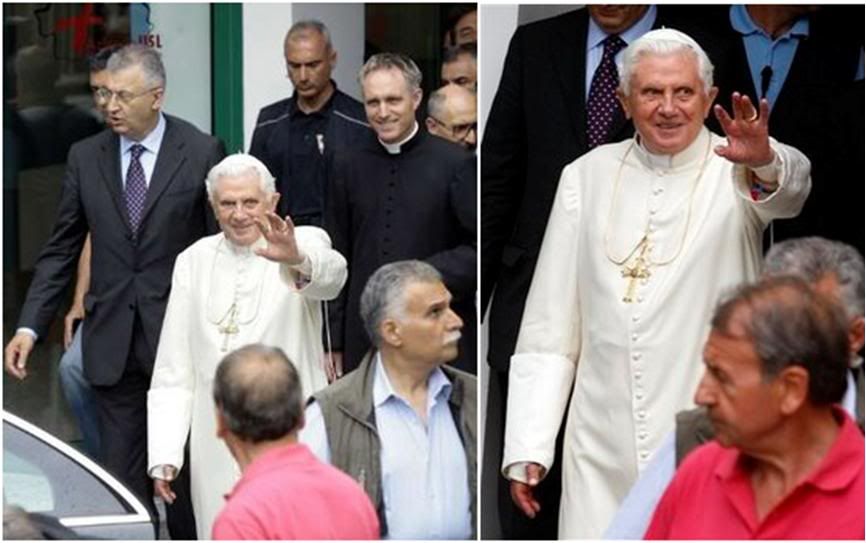 Dr. Polisca is behind him, left. Does one of his fingers also look bandaged up? The resin cast seems neat!
Dr. Polisca is behind him, left. Does one of his fingers also look bandaged up? The resin cast seems neat!

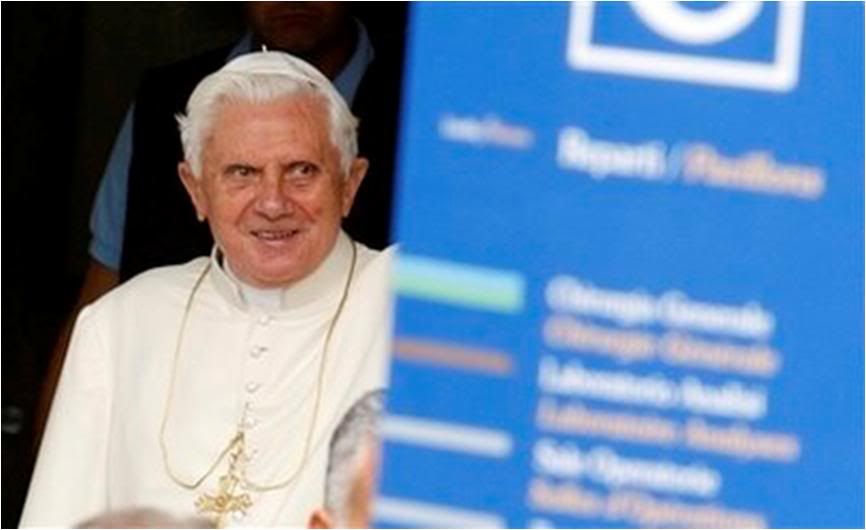
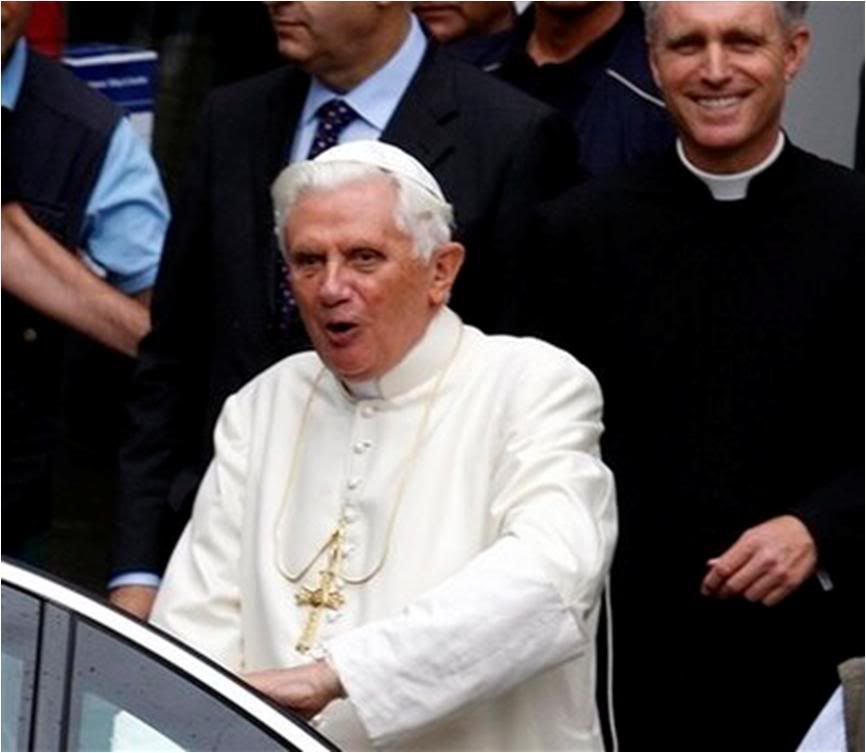
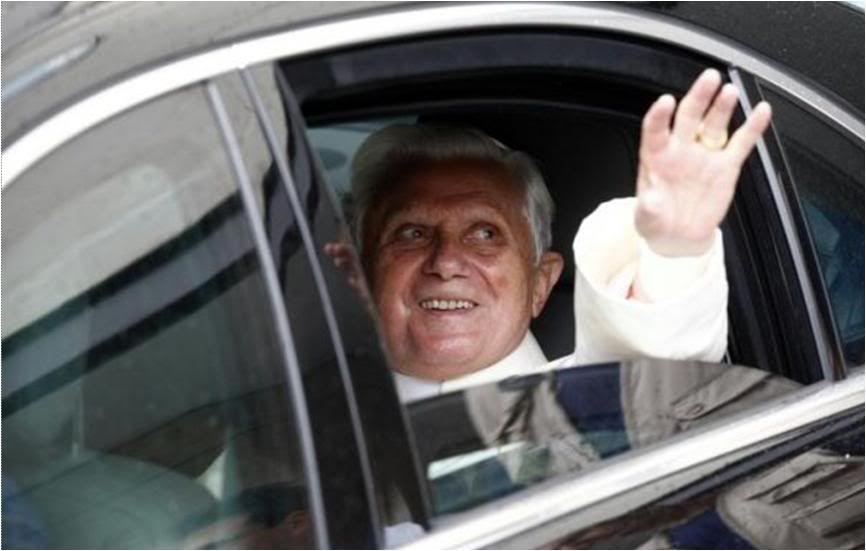
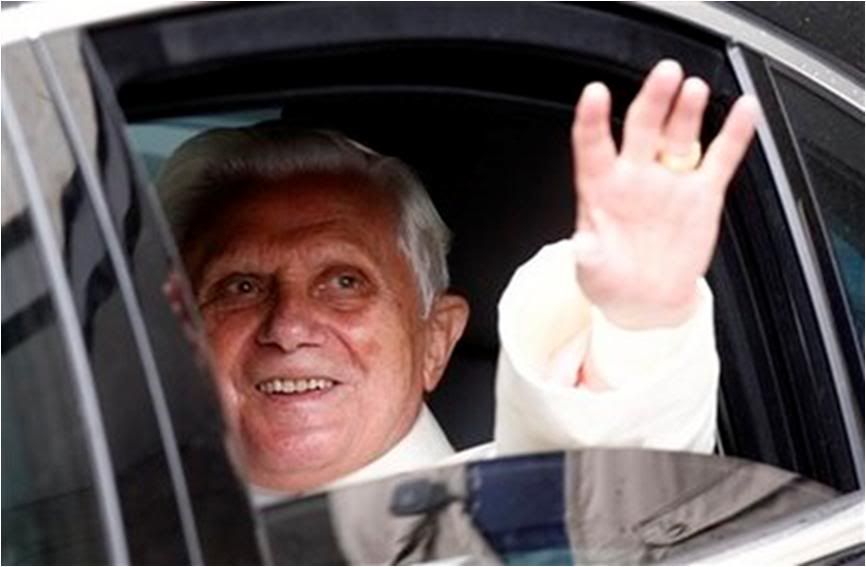 Pope fractures wrist in a fall,
Pope fractures wrist in a fall,
leaves hospital after six hours
by RACHEL DONADIO

July 17, 2009
ROME — Pope Benedict XVI fractured his right wrist in a fall Friday morning while on vacation in northern Italy, the Vatican said. He was released from the hospital after undergoing successful surgery.
Vatican officials were quick to diffuse any alarm over the first medical intervention known to the public since the 82-year-old became Pope in 2005.
“It’s nothing serious,” the Vatican spokesman, the Rev. Federico Lombardi, said in a telephone interview. He said doctors had ruled out that Benedict had been taken ill before falling. [An Italian news report said the Pope had slipped accidentally, not because of dizziness or any medical reason. I hope they make sure all his indoor footwear have non-skid soles and non-skid runners on his bathroom fllor.]
Doctors operated on the Pope’s wrist for about 20 minutes, Reuters reported. Father Lombardi called the operation “not difficult.” He said that doctors had inserted pins to help the Pope’s wrist heal, using local anesthetic. [The report does not make clear that the surgery was done without making any cuts at all - it makes it sound more involved than it was. But then, how do you report properly from Rome on something happening in Aosta?]
He added that the Pope would have to wear a cast for about a month. News photos showed Benedict leaving the clinic smiling and waving with his left hand.
In a statement released by the Vatican, the Pope’s private physician, Patrizio Polisca, said that Benedict was “in good condition.”
The Vatican said that the Pope had slipped overnight in his room in the chalet where he is staying in the mountainous Valle d’Aosta region.
Father Lombardi said that Mr. Polisca, who travels with the Pope, was in Val d’Aosta when the Pope fell and oversaw the local doctors who performed the operation.
In a statement, the Vatican said that Benedict was well enough to eat breakfast and celebrate Mass before being taken by car to the local hospital on Friday morning.
After meeting President Obama last Friday, the Pope arrived on Monday in northwest Italy, where he is scheduled to remain on vacation until July 29. He is then expected to return to his summer residence at Castel Gandolfo outside Rome until September.
Father Lombardi said it remained to be seen whether the Pope would keep his two scheduled commitments: delivering an Angelus message in two parishes near Aosta on the coming two Sundays. [Did he really say that? Come on! The Pope wouldn't cancel an Angelus appearance because of a broken wrist!]
In recent months, the Pope, who turned 82 in April, has appeared tired in some of his public appearances. But Benedict, a shy scholar, has kept up a public schedule, including an eight-day trip to Jordan, Israel and the Palestinian territories in May.
About questionable journalistic practices, the Daily Telegraph of London had its correspondent in Perugia reporting on the Pope's accident and he filed a pretty long first story alleging the Pope ahd broken his wrist and twisted his ankle. The Telegraph has yet to correct the story.

 L'Osservatore Romano is able to report on the Pope's little accident in tommorrow's issue at least up to Dr. Polisca's statement that the Holy Father would be returning home to Les Combes shortly but obviously went to press before the Pope left the hospital.
L'Osservatore Romano is able to report on the Pope's little accident in tommorrow's issue at least up to Dr. Polisca's statement that the Holy Father would be returning home to Les Combes shortly but obviously went to press before the Pope left the hospital.
It does, however, tells us something of what the Pope did Thursday, when the picture below was taken.
 A small incident stirs up
A small incident stirs up
the Pope's vacation:
A right wrist fracture
after a fall
Translated from
the 7/18/09 issue of

A small incident has stirred up Benedict XVI's vacation in Les Combes, Val D'Aosta.
As reported in two communiques made by the Vatican Press Office after the Holy Father accidentally slipped in his room on Thursday night, he sustained an incomplete fracture of the right wrist.
In the morning, the Pontiff nevertheless celebrated his daily Mass and had breakfast before going to the hospital in Aosta.
According to second communique issued by Dr. Patrizio Polisca, the Pope's personal physician, in the early afternoon, the Holy Fahter underwent "reduction of the fracture and osteosynthesis under local anesthesia, with the application thereafter of a cast", his overall condition was good, and he was expected to go back to Les Combes the same day.
On Thursday afternoon, the Pope left the residence at Les Combes for a walk along the Pileo-Boregue-Leytin municipal road, accompanied by his private secretary, Mons. Georg Gaenswein, during which they prayed the rosary.
Then he stopped at the Chalet du Pape, a small wooden cottage in the locality called Crois du Boix (cross of wood). It was built by the agricultural and forest council of Introd at the initiative of the commune, the diocese of Aosta and the Salesian community of Les Combes. The furnishings of the cottage were executed by local artisans.
At the main chalet, not the one described above.
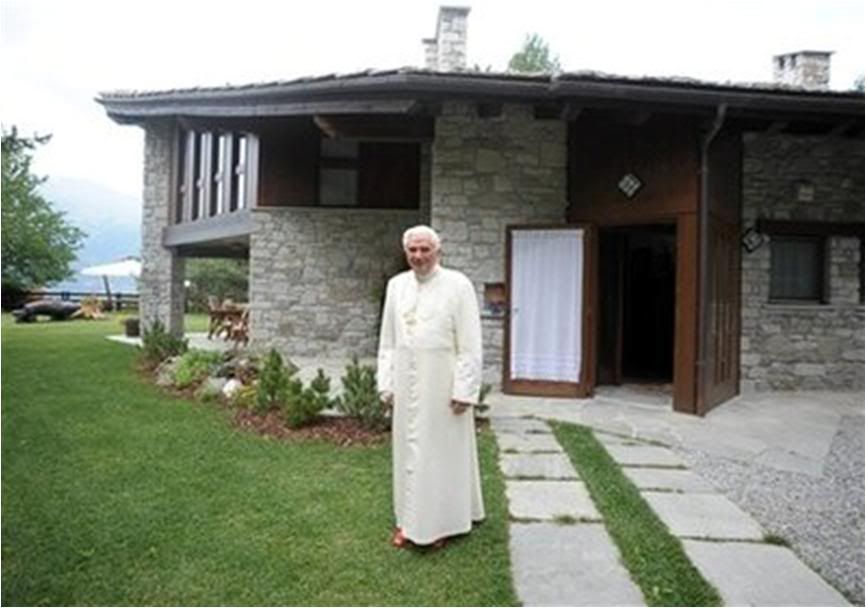 One thing quite obvious from all the media reports I managed to see in the past few hours is that hardly anyone - except thr Telegraph reporter who claimed the Pope also twisted his ankle - made more of the incident thatn it really was. And sensibly so.
One thing quite obvious from all the media reports I managed to see in the past few hours is that hardly anyone - except thr Telegraph reporter who claimed the Pope also twisted his ankle - made more of the incident thatn it really was. And sensibly so.
(Of course, lella notes that inexplicably, Corriere della Sera, in its online report of the incident, left ite combox open, which soon attracted alll kinds of nuts and ill-willed people. Why they should have kept the combox open at all in such a situation is just stupid.)
And now, AP's Victor Simpson has even filed a situationer on the Pope's health that, all things considered, one may call positive. Certainly, no untoward morbid interest!
Pope has been remarkably healthy
since assuming papacy
By VICTOR L. SIMPSON

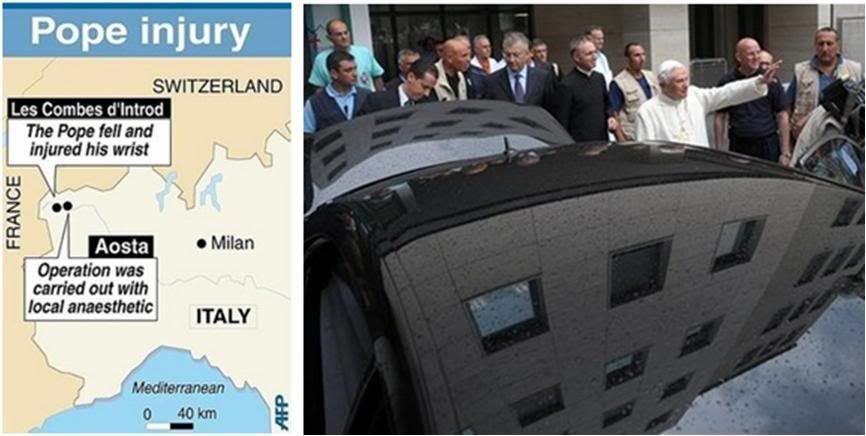
ROME, July 17 (AP) - Despite his age and a history of serious medical problems*, Pope Benedict XVI has been remarkably healthy during his four-year pontificate. He has kept to a busy schedule and traveled around the world.
Until breaking his right wrist in a fall in his vacation chalet in the Italian Alps on Friday, there have been no reported medical problems since he assumed the papacy in 2005.
"His general conditions are good," said his personal physician, Dr. Patrizio Polisca, in a Vatican medical bulletin issued after Benedict underwent surgery on his broken wrist.
Benedict, who turned 82 in April, said in a rare interview to German media in 2006 that "I've never felt strong enough to plan many long trips."
Since then, however, he has traveled to Australia, the United States, Brazil and most recently to two sub-Saharan African countries among his 12 foreign pilgrimages. While looking tired at times, he has always bounced back.
The most serious issue in his medical record was a hemorrhagic stroke he acknowledged suffering in 1991 that temporarily affected his vision, as well as a fall that knocked him unconscious in 1992. He has said he recovered without permanent damage from each incident. {I have never been clear about a second incident, or whether it happened at all.]
Doctors in Aosta, Italy, where was treated after the latest fall, took care emphasizing that the fall was accidental and not the result of a sudden illness.
And Dr. Amedeo Mancini, the orthopedic surgeon who performed Friday's operation, said the pope would suffer no long-term effects from the fracture, and would be able to write and play the piano once the wrist heals. He said Benedict was an excellent patient.
It came as a surprise that Benedict chose this region near France for his vacation, moving from Bressanone in the Alps near Austria, where he stayed last year. The mountain trails are steep in Aosta, and Benedict is known to prefer a flatter landscape where he can pursue leisurely walks.
His predecessor, the late John Paul II, went on taxing mountain hikes in summer and skied in the winter before he was slowed down by Parkinson's disease.
* ['A history of serious medical problems' seems an exaggeration, since so far as is known before he became Pope, it has consisted at the mostof a transient stroke - technically called a TIA, for transient ischemic attack, in which temporary disturbance of blood supply to an area of the brain results in a sudden, brief decrease in brain function and symptoms of stroke which lasts less than 24 hours.
Not a real stroke, but it could lead to a real one unless it is properly medicated]. This took place in the early 1990s, when he was over 60, which is not unusual in men at that age. For that, he has reportdly been taking blood-thinning medication (most likely one aspirin a day), gping by what his brother once said in an interview. Aspirin minimizes the likelihood of a blood clot that could lead to a real stroke or other complications.]
In any case - enjoy the rest of your vacation, dearest Papino. Do dictate to GG if you need some writing done!

ALL OUR LOVE AND PRAYERS
TO OUR DEAREST PAPINO
AND AS ALWAYS, WE WISH YOU
AD MULTOS ANNOS, SANCTE PATER!
 BTW, we must all thank Fr. Lombardi for the efficient way in which he managed the information flow today. He provided enough information in a timely manner to preclude unnecesary speculation. And I was pleasantly surprised to see a video on Fox News this afternoon that showed him when he announced the statements in his first communique in English - I am sure he did it in Italian, too - and he was very reassuring.
Meanwhile, more details are bound to emerge from this exciting six-hour news watch. Here are some from ANSA:
Benedict XVI was listed
BTW, we must all thank Fr. Lombardi for the efficient way in which he managed the information flow today. He provided enough information in a timely manner to preclude unnecesary speculation. And I was pleasantly surprised to see a video on Fox News this afternoon that showed him when he announced the statements in his first communique in English - I am sure he did it in Italian, too - and he was very reassuring.
Meanwhile, more details are bound to emerge from this exciting six-hour news watch. Here are some from ANSA:
Benedict XVI was listed
as 'Unknown Patient 917'

AOSTA, July 17 (Translated from NASA) - To protect the secrecy of his medical records, the Holy Father was entered into the records of the Umberto Parini Hospital as 'Unknown Patient 917'.
[But what privacy when ANSA obviously managed to get a copy of his Operative Report????? And has now told the world that Patient 917 is the Pope? Thankfully, the Op Report is merely medical jargon for what his surgeon earlier told newsmen.]
This was gleaned from the Operative Report on the procedure undergone by the Pope to reduce a 'meta-epiphyseal distal incomplete fracture of the right radius bone' [which would correspond to the right diagram of the two I posted earlier].
The procedure was performed under local anesthesia in Operating Room 1 of the emergency department of the regional hospital and lasted 25 minutes.
The surgical team was composed of orthoepdists Amedeo Mancini and Laura Mus, and anesthesiologist Marco Fondi.
The description of the procedure says that "under controlled digital fluoroscopy lasting 51 seconds, the fracture was reduced, after which osteo-synthesis was performed by introducing two Kirschner pins percutaneously."
[Digital fluoroscopy is an updated X-ray technique whicn enables detailed imaging of an internal body part which can be seen in real time on a monitor - in this case, the fracture was visualized so that the bone coudl be properly re-aligned.
Kirchner pins are flexible wires driven into the bone using a percutaneous microdrill that goes through the skin - sort of like a sophisticated staple gun. The pins secure the bone parts together to insure proper healing.]
Afterwards, the doctors checked the "stability of the reduction, which was found to be optimal, administered the necessary medications, and performed other post-procedure checks, before attaching a n immobilizing metacarpal device" [the resin cast described to newsmen earlier by Dr. Mancini].
The Pope thanks his surgical team and the rest of the Emrgency Room staff. Dr. Polisca is right behind him.
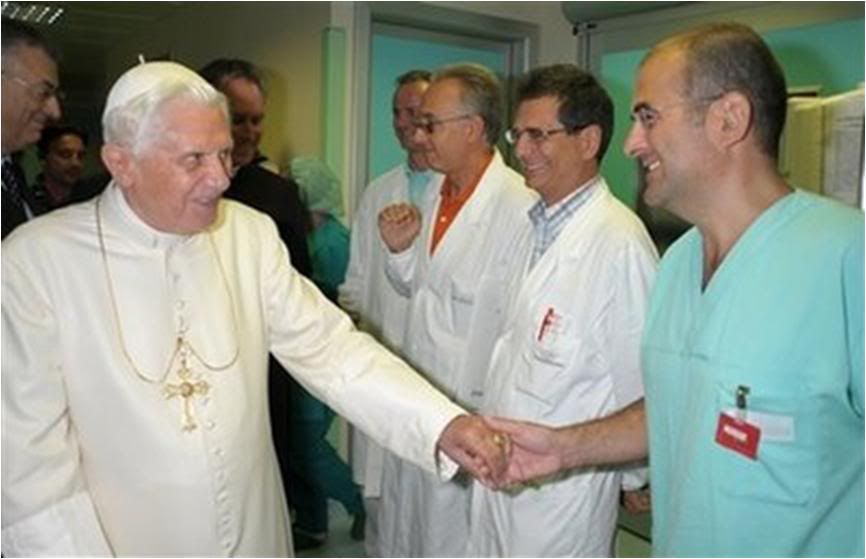
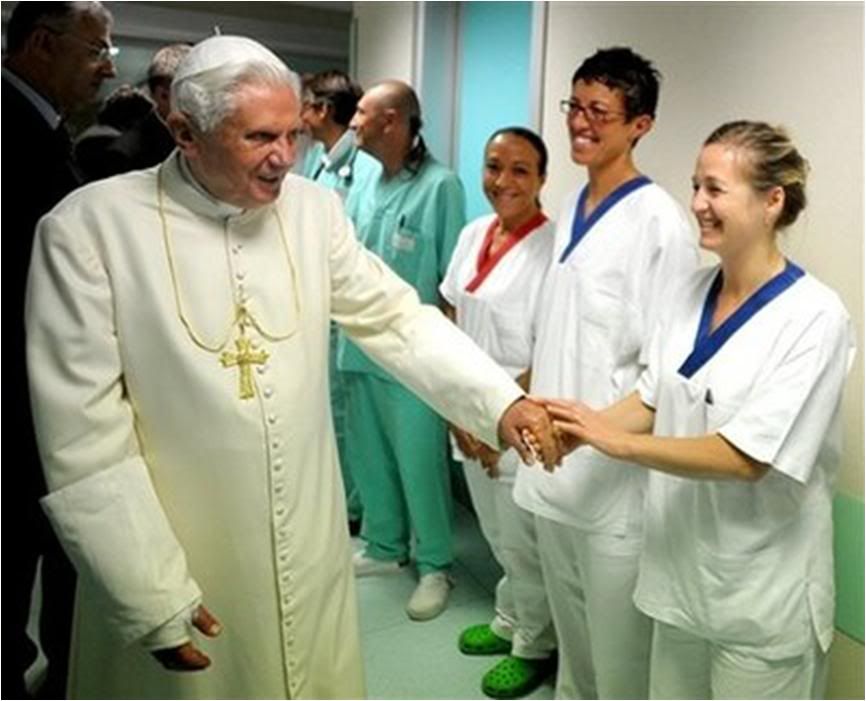
[Modificato da TERESA BENEDETTA 17/07/2009 22:52] |
| |
|
|
|
|